Symbol Technologies MC75A8 EDA (Enterprise Digital Assistant) User Manual MC75A User Guide
Symbol Technologies Inc EDA (Enterprise Digital Assistant) MC75A User Guide
Contents
user manual 3 rev
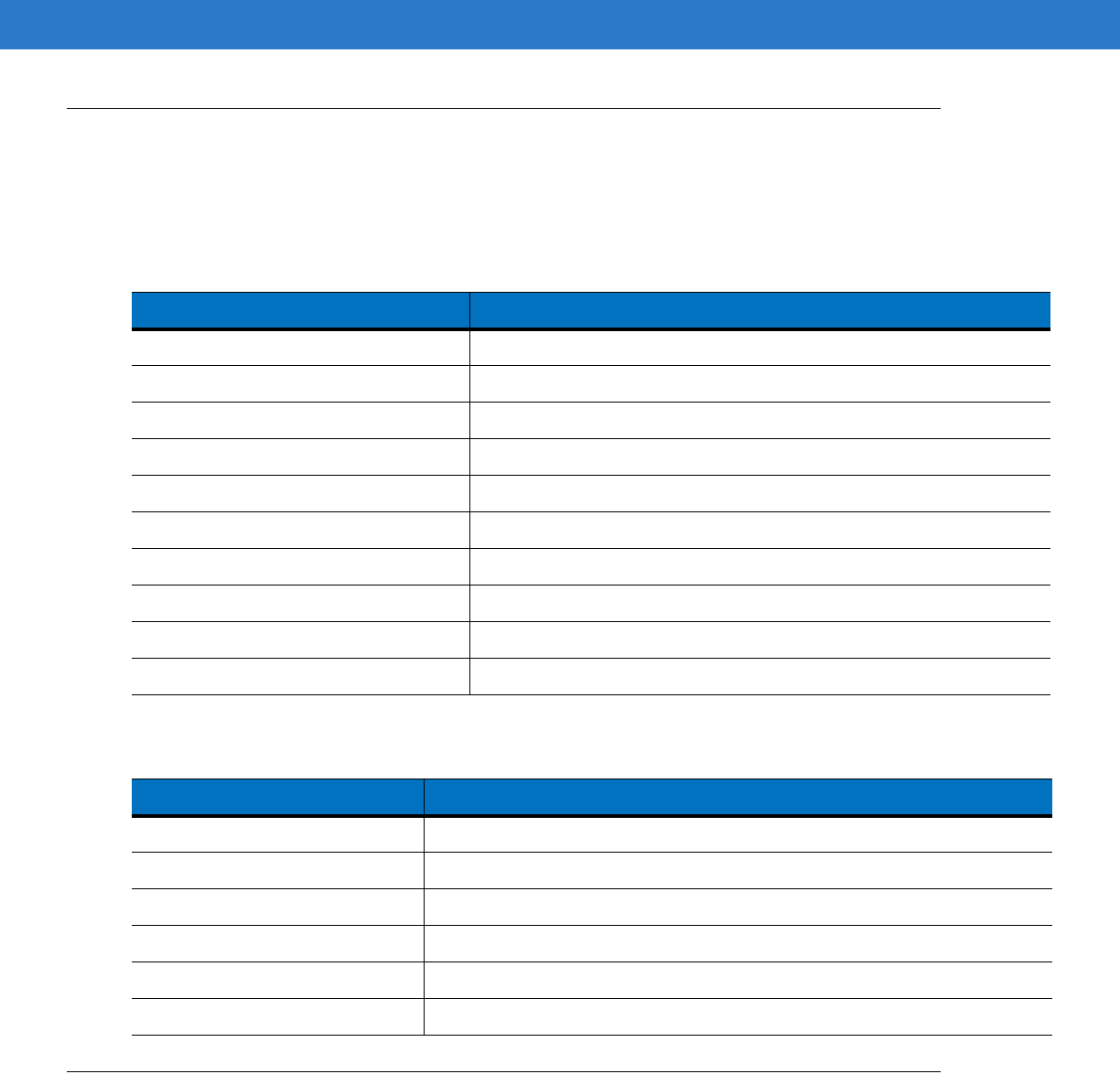
Using Bluetooth 6 - 3
Bluetooth Configuration
By default, the MC75A is configured to using the Microsoft Bluetooth stack. Refer to the MC75A Mobile Computer
Integrator Guide, Appendix B, for information on switching to the StoneStreet One Bluetooth stack.
Table 6-1 list the services supported by the Microsoft Bluetooth stack and the StoneStreet One Bluetooth stack.
Table 6-2 list the COM ports available for the Microsoft Bluetooth stack and the StoneStreet One Bluetooth stack.
Bluetooth Power States
Cold Boot
With StoneStreet One Bluetooth Stack
Performing a cold boot on the MC75A turns off Bluetooth after initialization (which takes a few moments). It is
normal to see the Bluetooth icon appear and disappear (when using the Classic Home screen), as well as a wait
cursor, when initialization proceeds in all modes.
Table 6-1
Bluetooth Services
Microsoft Bluetooth Stack StoneStreet One Bluetooth Stack
OBEX Object Push Services OBEX Object Push Services
Hands-Free Audio Gateway Services Hands-Free Audio Gateway Services
Serial Port Services Serial Port Services
Personal Area Networking Services Personal Area Networking Services
PBAP Services IrMC Services
Dial-Up Networking Services Dial-Up Networking Services
HID Client Services HID Client Services
A2DP/AVRCP Services A2DP/AVRCP Services
File Transfer Services
Headset Audio Gateway Services
Table 6-2
COM Ports
Microsoft Bluetooth Stack StoneStreet One Bluetooth Stack
COM5 COM5
COM9 COM9
COM11
COM21
COM22
COM23
DRAFT

6 - 4 MC75A Enterprise Digital Assistant User Guide
With Microsoft Bluetooth Stack
Performing a cold boot retain the state of the Bluetooth radio prior to the cold boot.
Warm Boot
With StoneStreet One Bluetooth Stack
Performing a warm boot on the MC75A turns off Bluetooth.
With Microsoft Bluetooth Stack
Performing a warm boot retain the state of the Bluetooth radio prior to the warm boot.
Suspend
When there is an active Bluetooth connection, the Bluetooth radio goes into low power mode maintaining the active
connection. When there is no active connection, the Bluetooth radio turns off.
With StoneStreet One Bluetooth Stack
With Microsoft Bluetooth Stack
Resume
When the MC75A resumes, Bluetooth turns on if it was on prior to suspend.
Using Microsoft Bluetooth Stack
The following sections provide information on using the Microsoft Bluetooth stack.
Turning the Bluetooth Radio Mode On and Off
Turn off the Bluetooth radio to save power or if entering an area with radio restrictions (e.g., an airplane). When the
radio is off, other Bluetooth devices cannot see or connect to the MC75A. Turn on the Bluetooth radio to exchange
information with other Bluetooth devices (within range). Communicate only with Bluetooth radios in close proximity.
Enabling Bluetooth
To enable Bluetooth:
NOTE If there is an active Bluetooth connection between the MC75A and another Bluetooth device, the MC75A will
not timeout. However, if the user presses the Power button on the MC75A, the MC75A will suspend (except
when on a call) and upon receiving data from a remote Bluetooth device, the MC75A will wake from suspend
mode. For example, headset redial or Bluetooth scanner sending data to the MC75A.
NOTE If there is an active Bluetooth connection between the MC75A and another Bluetooth device and there is no
data activity, the MC75A will timeout. However, if the user presses the Power button on the MC75A, the
MC75A will suspend (except when on a call) and upon receiving data from a remote Bluetooth device, the
MC75A will wake from suspend mode. For example, headset redial or Bluetooth scanner sending data to the
MC75A.
NOTE To achieve the best battery life turn off radios not in use.
DRAFT
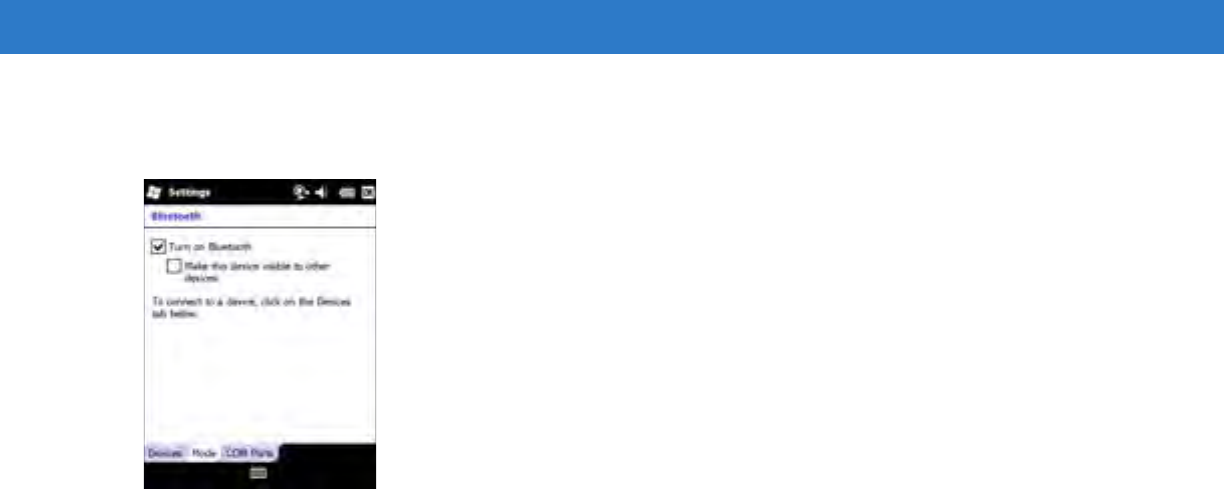
Using Bluetooth 6 - 5
1. Tap Wireless Manager and then tap the Bluetooth bar or
Tap Start > Setting > Connections > Bluetooth icon > Mode tab.
Figure 6-1
Bluetooth Mode Tab
2. Check the Turn On Bluetooth checkbox.
3. Tap OK.
Disabling Bluetooth
To disable Bluetooth:
1. Tap Wireless Manager and then tap the Bluetooth bar or
Tap Start > Setting > Connections > Bluetooth icon > Mode tab.
2. Un-check the Turn On Bluetooth checkbox.
3. Tap OK.
Discovering Bluetooth Device(s)
The MC75A can receive information from discovered devices without bonding. However, once bonded, the MC75A
and a bonded device exchange information automatically when you turn the Bluetooth radio on. See Bonding with
Discovered Device(s) on page 6-32 for more information.
To find Bluetooth devices in the area:
1. Ensure that Bluetooth is enabled on both devices.
2. Ensure that the Bluetooth device to discover is in discoverable and connectable modes.
3. Ensure that the two devices are within 30 feet (10 meters) of one another.
4. Tap Start > Settings > Connections tab > Bluetooth icon > Devices tab.
DRAFT
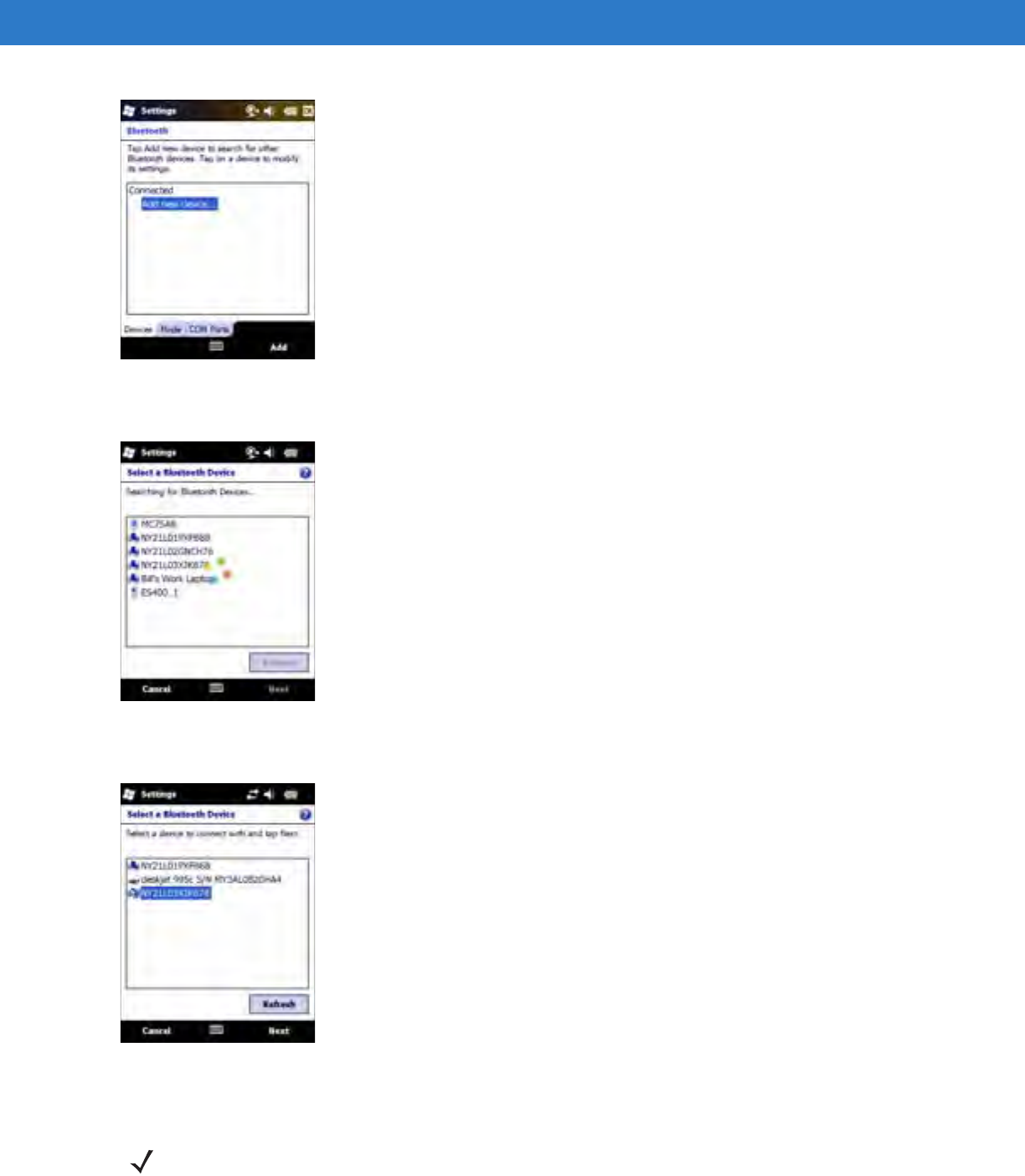
6 - 6 MC75A Enterprise Digital Assistant User Guide
Figure 6-2
Bluetooth - Devices Tab
5. Tap Add new device. The MC75A begins searching for discoverable Bluetooth devices in the area.
Figure 6-3
Searching for Bluetooth Devices
6. Select a device from the list.
Figure 6-4
Select a Bluetooth Device
7. Tap Next. The Enter Passcode window appears.
NOTE If Smart-pairing is configured and the device is requesting one of the pre-defined PINs, the Enter
Passcode window does not appear.
DRAFT
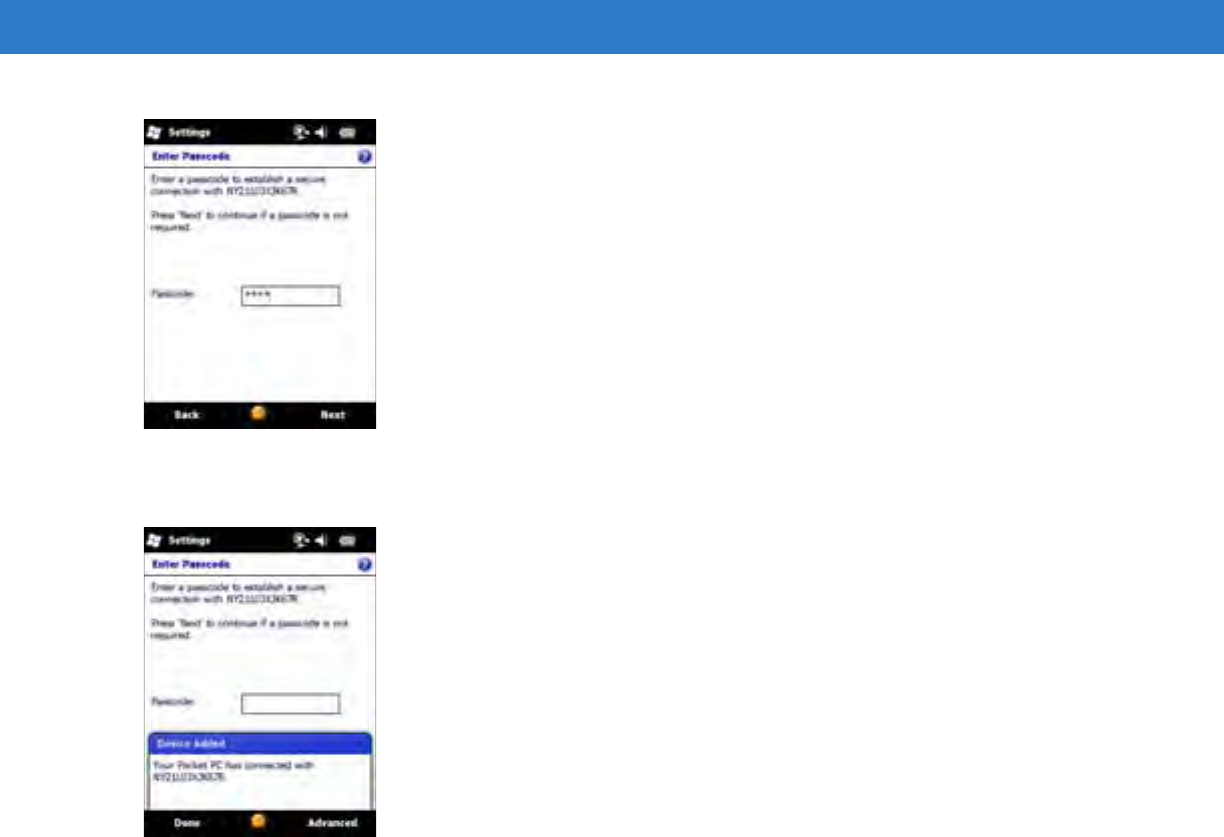
Using Bluetooth 6 - 7
Figure 6-5
Enter Passcode
8. Enter the Passcode on the other device. The device is added to the Bluetooth list.
Figure 6-6
Bluetooth Connection Confirmation
You are prompted to enter a passcode. If the device has a specific passcode, enter it in the Passcode field and
tap Next. If the device does not have a specific passcode, enter a passcode in the Passcode field and tap
Next. The Bluetooth radio tries to connect with the device.
9. If you created a passcode, you will be prompted by the other device to enter the same passcode. Enter the
created passcode to establish a paired connection. (If you entered a passcode from the device, you shouldn’t
have to do anything on the other device.)
10. When the connection is complete, a list of matching and supported services on the device appears.
11. Select the services you want to use and tap Finish. The services on the new devices have to be selected or
else the pairing won’t include those services, even though the devices are paired. If services are not selected,
you will be continually reprompted for the passcode from the device.
12. The device appears in the list on the main window.
After the passcodes have been accepted on both sides, you have a trusted (“paired”) connection.
DRAFT

6 - 8 MC75A Enterprise Digital Assistant User Guide
Available Services
See the following sections for information on available services.
Object Push Services via Beam
Use the OBEX Push Service to send files and contacts to another Bluetooth device. To transfer files between the
MC75A and another Bluetooth enabled device:
1. Ensure that Bluetooth is enabled and discoverable on both devices.
2. Ensure that the two devices are within 30 feet (10 meters) of one another.
3. Tap Start > Programs > File Explorer.
4. Navigate to the file to transfer.
5. Tap and hold on the filename until the pop-up menu appears.
Figure 6-7
File Explorer Window
6. Select Beam File. The MC75A searches for Bluetooth devices in the area.
7. Tap Tap to send next to the Bluetooth device to send the file to. The MC75A communicates with the device
and send the file. When completed, Tap to send changes to Done.
NOTE Some devices might not require a PIN. This depends upon the device’s authentication.
NOTE You can only send files to a remote device using the Beam function.
DRAFT
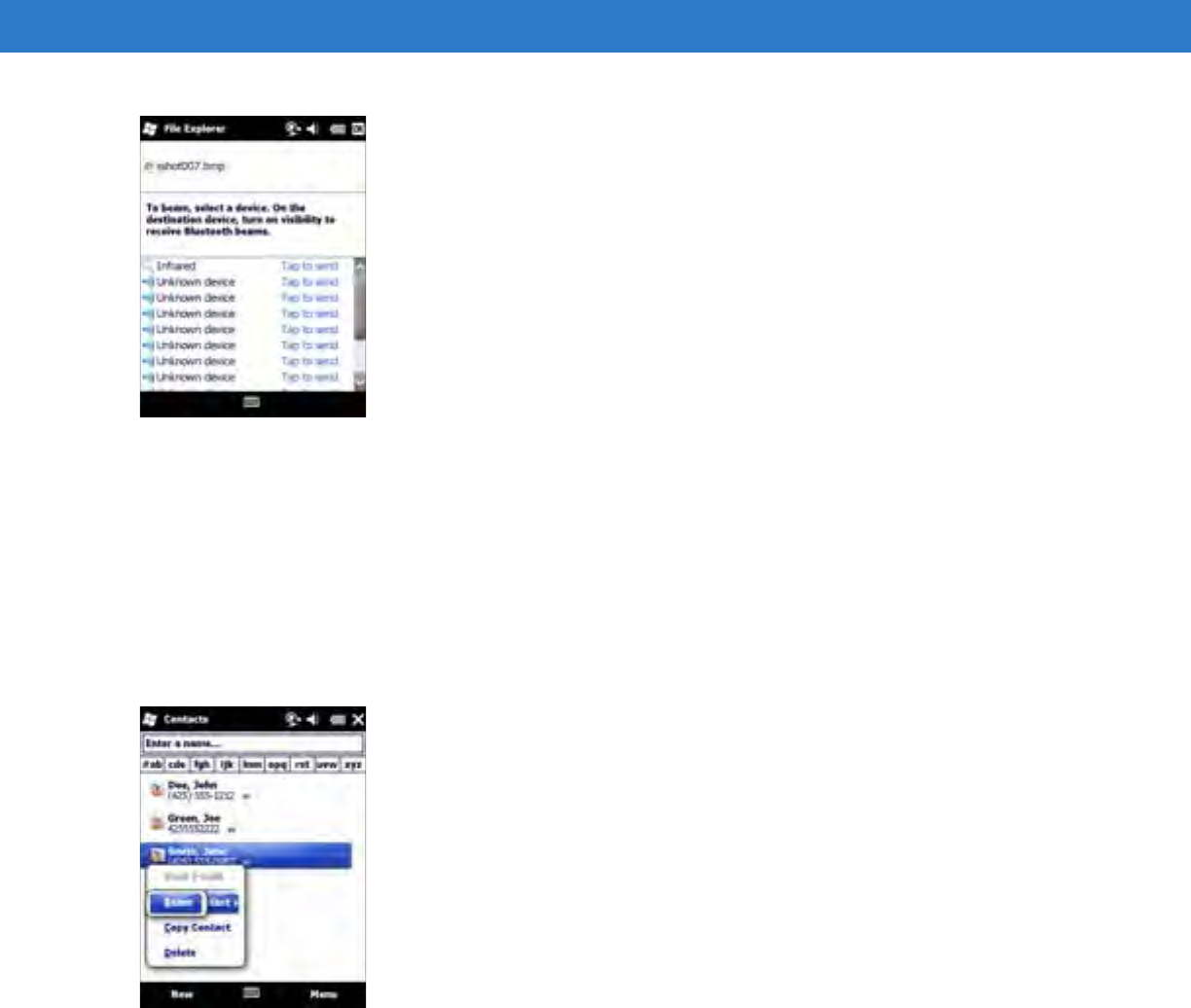
Using Bluetooth 6 - 9
Figure 6-8
Beam File Window
To transfer a contact between the MC75A and another Bluetooth enabled device:
1. Ensure that Bluetooth is enabled and discoverable on both devices.
2. Ensure that the two devices are within 30 feet (10 meters) of one another.
3. Tap Start > Contacts
4. Navigate to the contact to transfer.
5. Tap and hold on the contact until the pop-up menu appears.
Figure 6-9
Contact Window
6. Select Send Contact > Beam. The MC75A searches for Bluetooth devices in the area.
7. Tap Tap to send next to the Bluetooth device to send the file to. The MC75A communicates with the device
and send the contact. When completed, Tap to send changes to Done.
Internet Sharing
Internet Sharing allows the user to connect a computer or laptop to the MC75A and use the MC75A as a modem to
connect to an office network or ISP.
To use MC75A as a modem using Bluetooth:
1. Ensure that the device is not connected to the computer or laptop.
2. On the MC75A, ensure that the Phone is on and a data connection is configured.
DRAFT

6 - 10 MC75A Enterprise Digital Assistant User Guide
3. Tap > Programs > Internet Sharing.
4. In the PC Connection list, select Bluetooth PAN.
5. In the Network Connection list, select the connection type.
Select the network connection that the device should use to connect to the Internet.
6. Tap Connect.
7. On the computer or laptop, setup a Bluetooth PAN with your device.
a. Select Start > Control Panel > Network Connections.
b. Under Personal Area Network, select Bluetooth Network Connection.
c. Right-click on Bluetooth Network Connection and select View Bluetooth network devices.
d. In the Bluetooth Personal Area Network Devices window select your device.
e. Click Connect. The computer connects to the device via Bluetooth.
8. To verify, on the PC or laptop, launch Internet Explorer and open a web site.
9. To end dial-up networking, on the MC75A tap Disconnect.
Hands-free Services
To connect to a Bluetooth headset:
1. Ensure that Bluetooth is enabled and discoverable on both devices.
2. Ensure that the two devices are within 30 feet (10 meters) of one another.
3. Tap Start > Settings > Connections > Bluetooth icon.
4. Tap New device. The MC75A searches for Bluetooth devices in the area.
5. Select the headset name and tap Next. The Passcode window appears.
6. Enter the headset’s passcode.
7. Tap Next. The MC75A connects to the headset. Refer to the headset user manual for instructions on
communicating with a Bluetooth device.
NOTE If your computer is Bluetooth-enabled and you select Bluetooth as the PC connection, you must initiate and
complete the Bluetooth PAN partnership before Internet Sharing will work. For more information, refer to
Windows Help and Support.
NOTE Newer Bluetooth headsets are device dependant and remember the last device they connected to. If problems
occur while connecting to the headset, place the headset in discovery mode. Refer to the headset user manual
for more information.
Only WAN audio is routed to the headset. System audio is still emitted through the MC75A speaker.
You can accept calls and re-dial using the Hands-free profile.
NOTE During an active connection, the MC75A cannot go into suspend mode when the Power Button is
pressed. A message appears notifying the user.
Once the WAN call is disconnected (with Hands-free profile) the Power button is enabled.
DRAFT
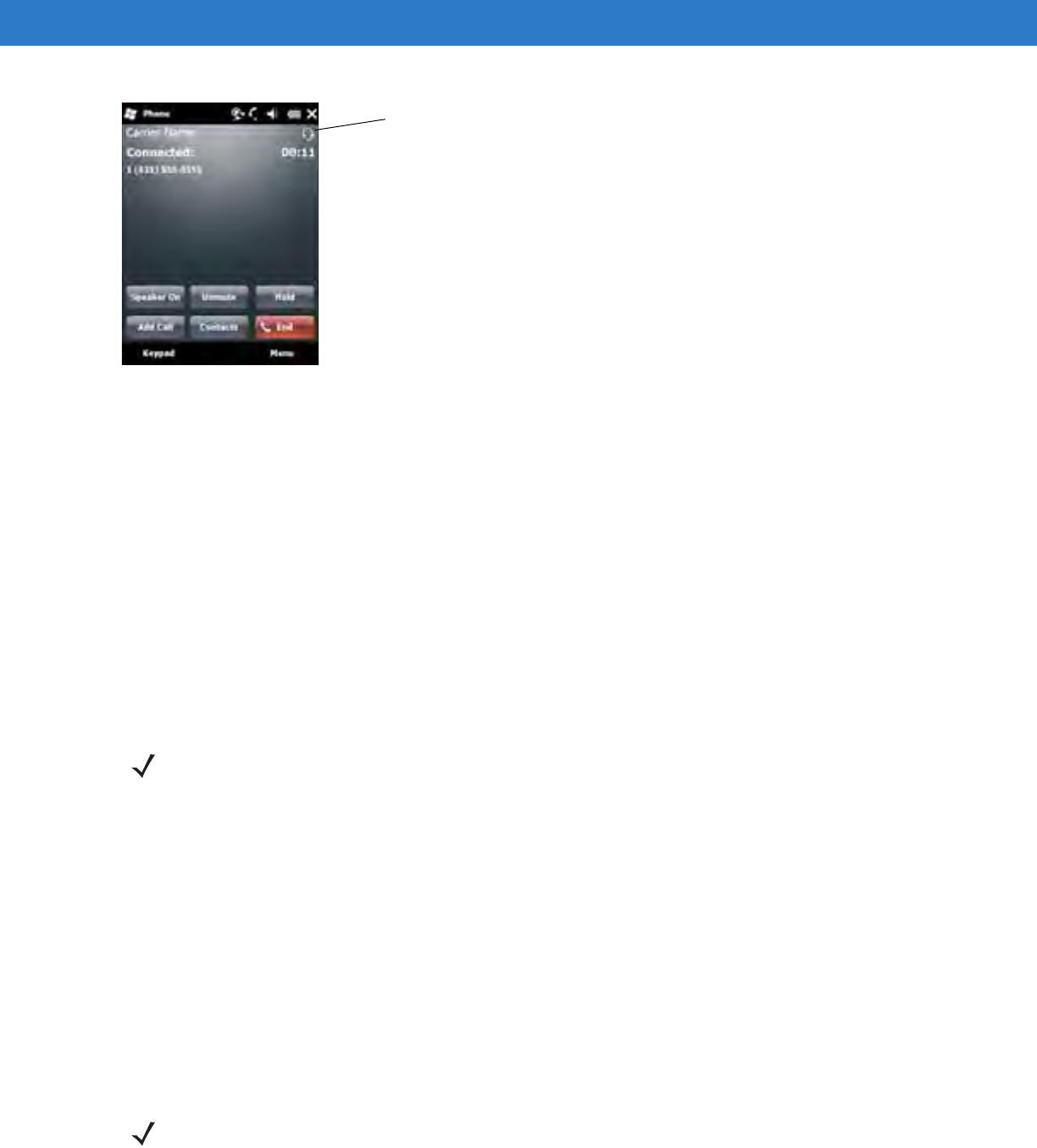
Using Bluetooth 6 - 11
Figure 6-10
WWAN Bluetooth Audio Notification Dialog Box
Serial Port Services
Use the wireless Bluetooth serial port connection as you would a physical serial cable connection. Configure the
application that will use the connection to the correct serial port.
To establish a serial port connection:
1. Ensure that Bluetooth is enabled and discoverable on both devices.
2. Ensure that the two devices are within 30 feet (10 meters) of one another.
3. Tap Start > Settings > Connections tab > Bluetooth icon > Devices tab.
4. Tap Add new device. The MC75A begins searching for discoverable Bluetooth devices in the area.
5. Select a device from the list.
6. Tap Next. The Enter Passcode window appears.
7. Enter the Passcode and the tap Next. The device is added to the Bluetooth list.
8. In the device list, tap the serial device. The Partnership Settings window displays.
9. Select the Serial Port checkbox.
10. Ta p Save.
11. Tap COM Ports tab.
12. Ta p New Outgoing Port. The add device window appears.
13. Select the serial device in the list and then tap Next.
14. Select a COM port from the drop-down list.
15. Ta p Finish.
Headset icon
NOTE If Smart-pairing is configured and the device is requesting one of the pre-defined PINs, the Enter
Passcode window does not appear.
NOTE No connection is made at this point. An application must open the selected COM port to trigger Microsoft
Bluetooth stack to open the connection.
DRAFT

6 - 12 MC75A Enterprise Digital Assistant User Guide
ActiveSync Using Serial Port Services
Use the wireless Bluetooth serial port connection for ActiveSync just as you would a physical serial cable
connection. You must configure the application that will use the connection to the correct serial port.
To set up a Bluetooth ActiveSync connection:
Before setting up a Bluetooth ActiveSync connection, configure the Bluetooth function of your device.
1. Ensure that Bluetooth is enabled and discoverable on both devices.
2. Ensure that the two devices are within 30 feet (10 meters) of one another.
3. On the computer, click Start > Settings > Control Panel.
4. Double-click Bluetooth Devices.
5. On the Options tab, select the Turn discovery on and Allow Bluetooth devices to connect to this
computer checkboxes.
Figure 6-11
Computer Bluetooth Devices Window
6. On the COM Ports tab, click Add.
7. Select the Incoming (device initiates the connection) option, then click OK.
Note the number of the COM port that was added.
8. Click OK.
9. Click Start > All Programs > Microsoft ActiveSync.
10. Click File > Connection Settings.
NOTE For additional security, disable network bridging on the computer (specifically, bridging to a Remote NDIS
adapter) before connecting to the computer to pass though to the Internet or a network. For more information
on network bridging, see Windows Help on your computer.
The instructions below are for computers that support the Windows XP SP2 or later version operating system.
DRAFT
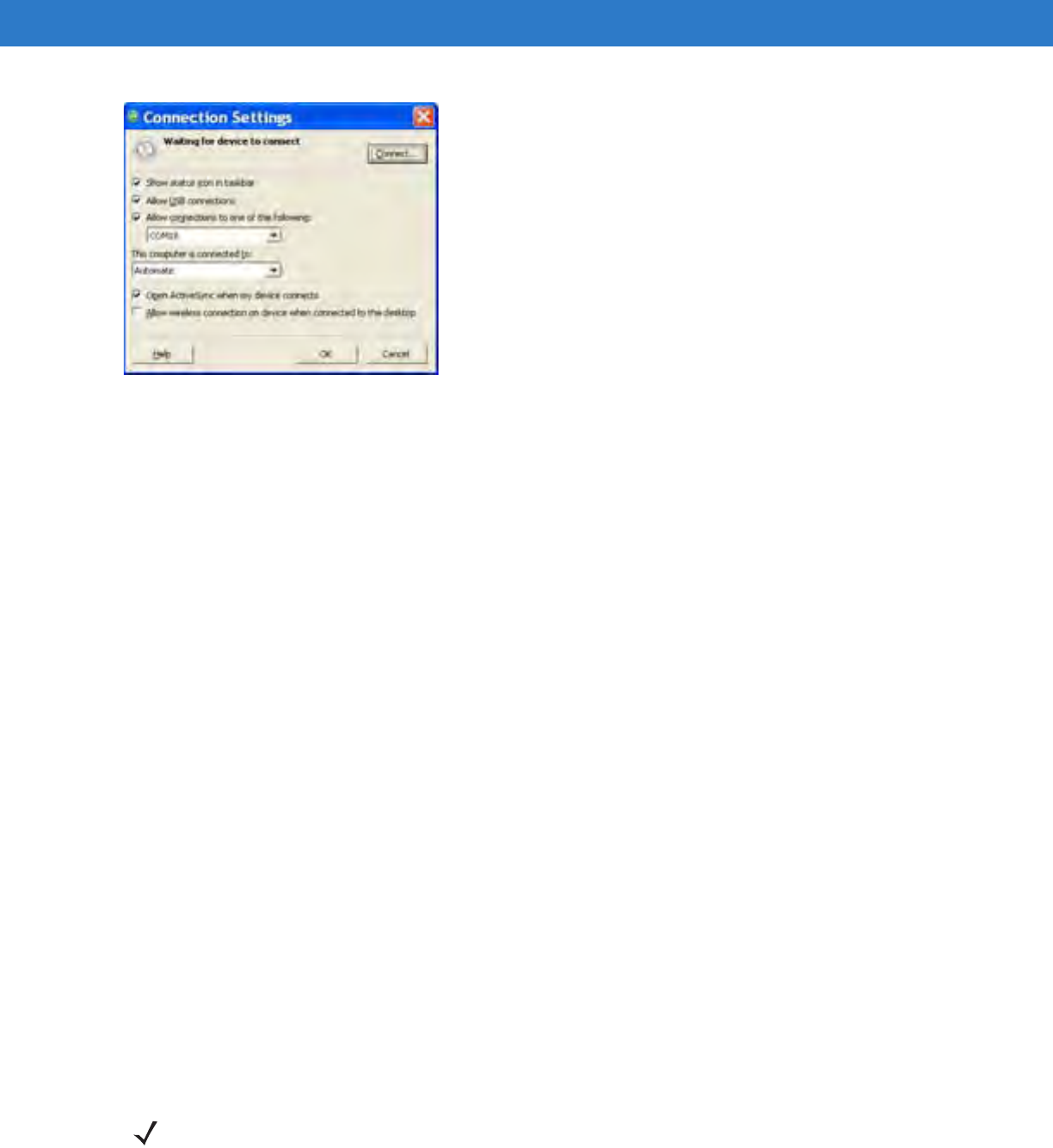
Using Bluetooth 6 - 13
Figure 6-12
ActiveSync Connection Settings
11. On the Allow connections to one of the following drop-down list, select the COM port with the number you
noted earlier.
12. On the MC75A, tap Start > Programs > ActiveSync.
13. Ta p Menu > Connect via Bluetooth.
Synchronization is automatically initiated. The ActiveSync icon appears on the lower right corner of the Today
screen.
If an Authentication is required, the Enter Passcode screen appears, type an alphanumeric passkey (PIN
code), then tap Next; enter the same passkey on the other device.
The passkey is recommended for enhanced security. Your passkey must be between 1 to 16 alphanumeric
characters.
If you do not want to use a passkey, tap Next.
14. To disconnect the ActiveSync connection, tap the ActiveSync icon on the Today screen.
15. Ta p Disconnect.
Phone Book Access Profile Services
Phone Book Access profile (PBAP) is used to synchronize contacts between a remote device and the MC75A. To
establish an PBAP synchronization:
1. Ensure that Bluetooth is enabled and discoverable on both devices.
2. Ensure that the two devices are within 30 feet (10 meters) of one another.
3. Tap Start > Settings > Connection tab > Bluetooth icon > Devices tab.
4. Tap Add New Device.The MC75A searches for a Bluetooth device, such as a Car Kit.
5. Select a device from the list.
6. Tap Next. The Enter Passcode window appears.
7. Enter the Passcode and the tap Next. The device is added to the Bluetooth list.
NOTE If Smart-pairing is configured and the device is requesting one of the pre-defined PINs, the Enter Passcode
window does not appear.
DRAFT

6 - 14 MC75A Enterprise Digital Assistant User Guide
8. A dialog box appears requesting if you want to transfer contacts to the car kit.
9. Select Yes or No.
10. If Yes is selected, contacts from the MC75A are transferred to the car kit.
Dial-Up Networking Services
Dial-up networking allows the user to connect a PC or laptop to the MC75A and use the MC75A as a modem to
connect to an office network or ISP.
Before setting up dial-up networking, obtain dial-up information and other necessary settings (username, password
and domain name, if required) for the office network or ISP. To create a new Bluetooth connection:
1. Ensure the MC75A is discoverable and connectable.
2. On the PC or laptop, set up Bluetooth according to the manufacturer’s instructions.
3. On the PC or laptop Bluetooth software, search for the MC75A and select the Dial-up Networking service.
4. Using dial-up software on the PC or laptop, connect to the MC75A.
5. The MC75A phone function dials the ISP number and connects to the ISP.
6. To verify, on the PC or laptop, launch Internet Explorer and open a web site.
Connect to a HID Device
The MC75A can connect to an Human Interface Device (HID) device such as a Bluetooth keyboard or mouse:
1. Ensure that Bluetooth is enabled on both devices.
2. Ensure that the Bluetooth device to discover is in discoverable and connectable modes.
3. Ensure that the two devices are within 30 feet (10 meters) of one another.
4. Tap Start > Settings > Connections tab > Bluetooth icon > Devices tab.
5. Tap Add new device. The MC75A begins searching for discoverable Bluetooth devices in the area.
6. Select a HID device from the list.
7. Tap Next. The Enter Passcode window appears. Refer to the device’s User Manuals for more information.
8. Tap Connect. The MC75A connects to the HID device.
A2DP/AVRCP Services
A2DP/AVRCP is used to connect to a high-quality stereo headset:
1. Ensure that Bluetooth is enabled on both devices.
2. Ensure that the Bluetooth device to discover is in discoverable and connectable modes.
3. Ensure that the two devices are within 30 feet (10 meters) of one another.
4. Tap Start > Settings > Connections tab > Bluetooth icon > Devices tab.
NOTE If Smart-pairing is configured and the device is requesting one of the pre-defined PINs, the Enter
Passcode window does not appear.
DRAFT

Using Bluetooth 6 - 15
5. Tap Add new device. The MC75A begins searching for discoverable Bluetooth devices in the area.
6. Select a stereo headset from the list.
7. Tap Next. The Enter Passcode window appears. Refer to the device’s User Manuals for more information.
8. Tap Connect. The MC75A connects to the stereo headset.
For stereo headsets that can use hands-free services, connect to the hands-free service after connecting to the
A2DP service:
1. Tap Start > Settings > Connections tab > Bluetooth icon > Devices tab.
2. Tap Add new device. The MC75A begins searching for discoverable Bluetooth devices in the area.
3. Select a stereo headset from the list.
4. Tap Next. The Enter Passcode window appears. Refer to the device’s User Manuals for more information.
5. Tap Connect. The MC75A connects to the stereo headset.
NOTE If Smart-pairing is configured and the device is requesting one of the pre-defined PINs, the Enter
Passcode window does not appear.
NOTE If Smart-pairing is configured and the device is requesting one of the pre-defined PINs, the Enter
Passcode window does not appear.
DRAFT
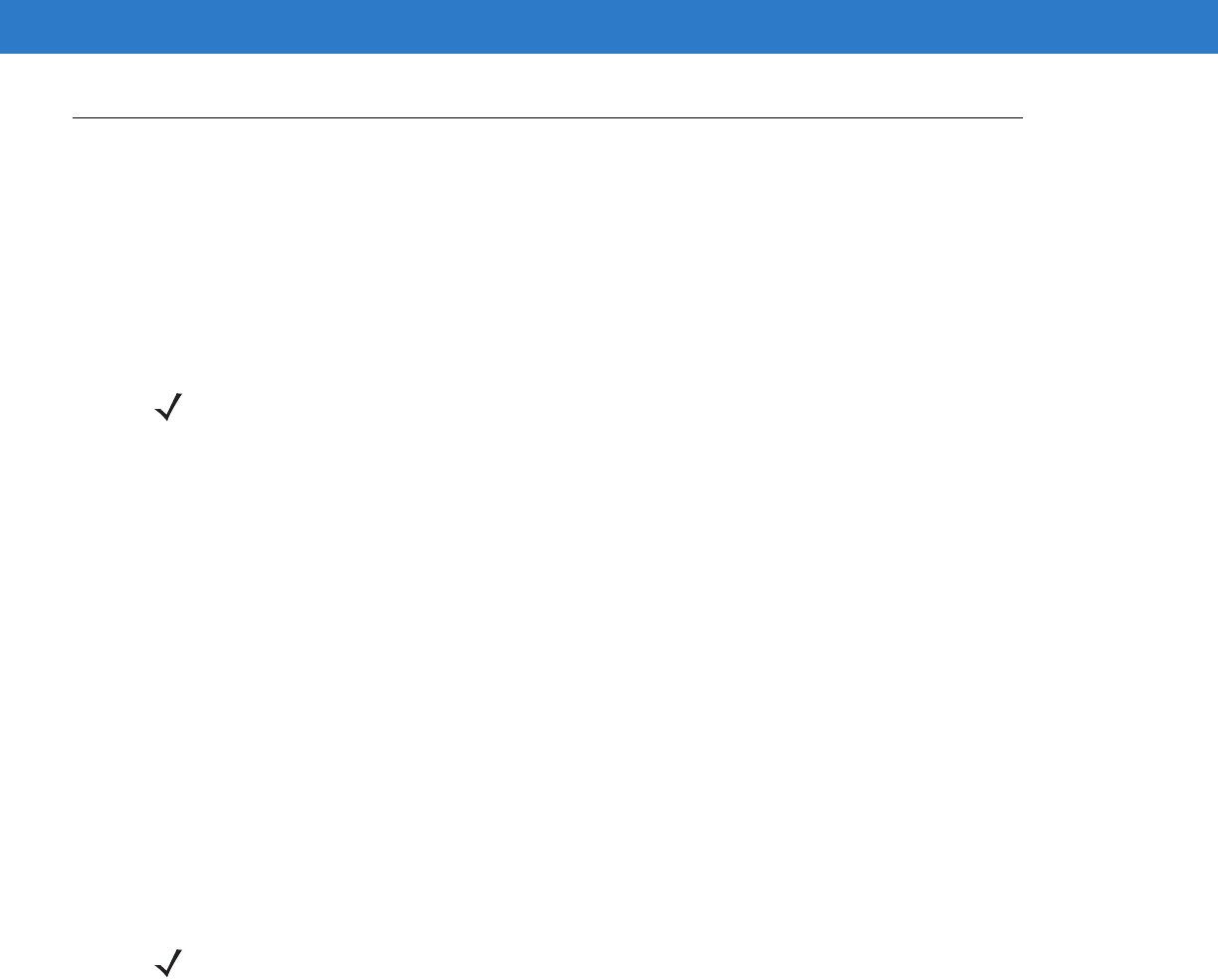
6 - 16 MC75A Enterprise Digital Assistant User Guide
Using StoneStreet One Bluetooth Stack
The following sections provide information on using the StoneStreet One Bluetooth stack.
Turning the Bluetooth Radio Mode On and Off
Turn off the Bluetooth radio to save power or if entering an area with radio restrictions (e.g., an airplane). When the
radio is off, other Bluetooth devices cannot see or connect to the MC75A. Turn on the Bluetooth radio to exchange
information with other Bluetooth devices (within range). Communicate only with Bluetooth radios in close proximity.
Disabling Bluetooth
To disable Bluetooth, tap the Connection icon on the Status bar and select Wireless Manager in the Connectivity
dialog box. Tap the blue Bluetooth bar to turn off the Bluetooth radio.
Enabling Bluetooth
To enable Bluetooth, tap the Connection icon on the Status bar and select Wireless Manager in the Connectivity
dialog box. Tap the blue Bluetooth bar to turn on the Bluetooth radio.
Modes
The BTExplorer application has two modes for managing Bluetooth connections: Wizard Mode and Explorer Mode.
The Wizard Mode is for novice Bluetooth users and the Explorer Mode is for experienced Bluetooth users. To
switch between modes, select View > Wizard Mode or View > Explorer Mode.
Wizard Mode
Wizard Mode provides a simple process for discovering and connecting to Bluetooth devices.
Wizard Mode shows the devices and services in a simple Favorites view created by following the step-by-step
wizard.
Explorer Mode
The Explorer Mode window is easy to navigate and provides greater control to users familiar with Bluetooth. The
menu bar provides quick access to the options and tools used to connect to devices. To access Explorer Mode, tap
View > Explorer Mode.
NOTE To achieve the best battery life turn off radios not in use.
NOTE Switching between Wizard Mode and Explorer Mode closes all active connections.
DRAFT

Using Bluetooth 6 - 17
Figure 6-13
Explorer Mode Window
You can also use the “tap and hold” technique to view available options. Scroll bars and view options are similar to
those on the Windows desktop. The tree structure lists the following sub-items:
•
Local Device - This device
•
Remote Device - Other Bluetooth devices
•Trusted Devices - Bonded (paired) Bluetooth devices
•Untrusted Devices - Discovered devices that are not bonded
•
Favorites - Selected services that are set as Favorite for quick access.
Discovering Bluetooth Device(s)
The MC75A can receive information from discovered devices without bonding. However, once bonded, the MC75A
and a bonded device exchange information automatically when you turn the Bluetooth radio on. See Bonding with
Discovered Device(s) on page 6-32 for more information.
To find Bluetooth devices in the area:
1. Ensure that Bluetooth is enabled on both devices.
2. Ensure that the Bluetooth device to discover is in discoverable and connectable modes.
3. Ensure that the require profile is enabled on the MC75A. See Profiles Tab on page 6-45 for more information.
4. Ensure that the two devices are within 30 feet (10 meters) of one another.
5. Tap Start > BTExplorer. The BTExplorer window appears.
6. Tap Menu > New Connection.The New Connection Wizard appears.
NOTE Switching between Wizard Mode and Explorer Mode closes all active connections.
NOTE If favorite connections have already been created, the Favorites screen displays. If no favorite connections
have been created, the New Connection Wizard screen displays.
DRAFT

6 - 18 MC75A Enterprise Digital Assistant User Guide
Figure 6-14
BTExplorer Window
7. Select Explore Services on Remote Device or another from the drop-down list and tap Next.
8. BTExplorer searches for Bluetooth devices in the area.
Figure 6-15
Discover Devices Dialog Box
The discovered devices display in the Select Remote Device window.
NOTE If a device discovery action has not been previously performed, a device discovery is automatically initiated. If
a device discovery has previously been performed, the device discovery process is skipped, and the
previously found list of devices displays. To start a new device discovery, tap and hold in the window and select
Discover Devices from the pop-up menu.
DRAFT

Using Bluetooth 6 - 19
Figure 6-16
Select Remote Device Window
9. Select a device from the list and tap Next. The MC75A searches for services on the selected Bluetooth device.
Figure 6-17
Device Services
10. Select a service from the list and press Next. The Connection Favorite Options window appears.
Figure 6-18
Connection Favorite Options Window
11. In the Favorite Name text box, enter a name for this service that will appear in the Favorite window.
NOTE If the MC75A discovers a service but the service is not supported, the service icon is grayed-out.
DRAFT

6 - 20 MC75A Enterprise Digital Assistant User Guide
12. Ta p Next. The Connection Summary window appears.
13. Ta p Connect to add the service to the Favorite window and connect to the service.
Figure 6-19
Favorites Window
Available Services
See the following sections for information on available services.
File Transfer Services
To transfer files between the MC75A and another Bluetooth enabled device:
1. Ensure that OBEX File Transfer profile is enabled on the MC75A. See Profiles Tab on page 6-45 for more
information.
2. Use the Connection Wizard to search for a Bluetooth device.
3. Select the device and tap Next. The Select Remote Service window appears.
4. Tap Next. The Connection Favorite Options window appears.
5. Tap Next. The Connection Summary window appears.
6. Tap Connect. The remote device’s accessible folders appear.
NOTE Some devices might not require a PIN. This depends upon the device’s authentication.
NOTE Shared folders are a security risk.
NOTE If favorite connections have already been created, the Favorites screen displays. If no favorite connections
have been created, the New Connection Wizard screen displays.
DRAFT
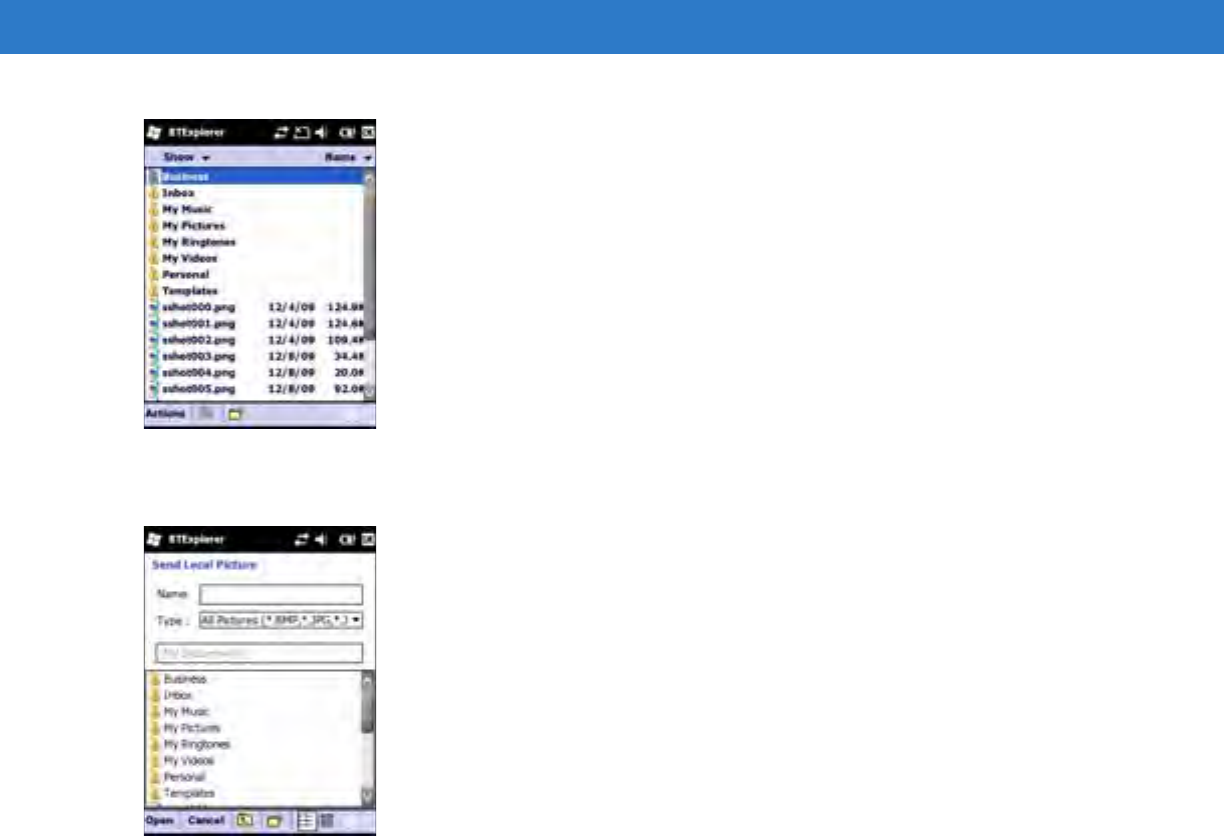
Using Bluetooth 6 - 21
Figure 6-20
File Transfer Window
7. Double-tap the file to copy. The Save Remote File window appears.
Figure 6-21
Save Remote File Window
8. Tap and hold on the file. A pop-up menu appears.
9. Select the action to perform:
•
New - create a new file or folder on the remote device
•
Delete - delete the selected file on the remote device.
•
Get File - copy the file from the remote device to the MC75A.
•
Put File - copy a file from the MC75A to the remote device.
Creating a New File or Folder
To create a new folder or file on the remote device:
1. Tap and hold on the screen and select New > Folder or New > File. The Create New Folder or Create New
File window appears.
2. Enter the name for the new folder or file.
3. Tap OK to create the new folder or file on the remote device.
DRAFT

6 - 22 MC75A Enterprise Digital Assistant User Guide
Deleting a File
To delete a file from the remote device:
1. Tap and hold on the file to delete and select Delete.
2. In the Delete Remote Device File dialog box tap Yes.
Getting a File
To copy a file from a remote device:
1. Double-tap or tap and hold on the file and select Get. The Save Remote File window appears.
2. Navigate to the directory to save the file.
3. Tap Save. The file is transferred from the remote device to the MC75A.
Copying a File
To copy a file to a remote device:
1. Tap Action > Put. The Send Local File window appears.
2. Navigate to the directory to save the file and select a file.
3. Tap Open. The file copies from the MC75A to the remote device.
Connecting to the Internet Using an Access Point
This section explains how to access a Bluetooth-enabled LAN access point (AP) for a network connection. Use
Internet Explorer to connect to a server.
1. Ensure the MC75A is discoverable and connectable. See Device Info Tab on page 6-34.
2. Ensure that the Personal Area Networking profile is enabled on the MC75A. See Profiles Tab on page 6-45
for more information.
3. Use the Connection Wizard to search for a Bluetooth AP.
4. Select the Personal Area Network or Network Access service and select Connect from the pop-up menu.
The MC75A connects with the access point.
5. Tap Start > Internet Explorer. The Internet Explorer window appears.
6. In the address field, enter an internet address and tap the Enter button. The web page loads.
Dial-Up Networking Services
Dial-up networking allows the user to connect a PC or laptop to the MC75A and use the MC75A as a modem to
connect to an office network or ISP.
Before setting up dial-up networking, obtain dial-up information and other necessary settings (username, password
and domain name, if required) for the office network or ISP. To create a new Bluetooth connection:
NOTE If favorite connections have already been created, the Favorites screen displays. If no favorite connections
have been created, the New Connection Wizard screen displays.
NOTE Network Access profile is not supported.
DRAFT

Using Bluetooth 6 - 23
1. Ensure the MC75A is discoverable and connectable. See Device Info Tab on page 6-34.
2. Ensure that the Dial-Up Networking profile is enabled on the MC75A. See Profiles Tab on page 6-45 for more
information.
3. Tap Menu > Settings > Services tab.
4. Tap Add button.
5. Select Dial-up networking Service.
6. Tap OK. The Edit Local Services window appears.
Figure 6-22
Edit Local Service Window
7. In the Local COM Port drop-down list, select DUN1 for GSM configurations or WMP9 for CDMA
configurations.
8. Tap OK twice.
9. On the PC or laptop, set up Bluetooth according to the manufacturer’s instructions.
10. On the PC or laptop Bluetooth software, search for the MC75A and select the Dial-up Networking service.
11. Using dial-up software on the PC or laptop, connect to the MC75A.
12. The MC75A phone function dials the ISP number and connects to the ISP.
13. To verify, on the PC or laptop, launch Internet Explorer and open a web site.
Object Exchange Push Services
Object Exchange (OBEX) is a set of protocols that allows sharing objects such as Contacts or pictures using
Bluetooth.
To exchange contact information with another Bluetooth enabled device:
1. Ensure the MC75A is discoverable and connectable. See Device Info Tab on page 6-34.
2. Ensure that the OBEX Object Push profile is enabled on the MC75A. See Profiles Tab on page 6-45 for more
information.
3. Use the Connection Wizard to search for a Bluetooth device.
NOTE If favorite connections have already been created, the Favorites screen displays. If no favorite connections
have been created, the New Connection Wizard screen displays.
DRAFT

6 - 24 MC75A Enterprise Digital Assistant User Guide
4. Select the device and tap Next.
5. Select the OBEX Object Push service and select Connect. The OBEX Object Push window appears.
6. In the Action drop-down list, select one of the following options: Send Contact Information, Swap Contact
Information, Fetch Contact Information, or Send a Picture.
Sending a Contact
To send a contact to another device:
1. Tap and hold on OBEX Object Push and select Connect. The OBEX Object Push window appears.
Figure 6-23
OBEX Object Push Window
2. In the Action: drop-down list, select Send Contact Information.
3. Tap . The Select Contact Entry window appears.
Figure 6-24
Select Contact Entry Window
4. Select a contact to send to the other device.
5. Tap OK.
6. Tap OK to send the contact to the other device and display a confirmation dialog box on the other device to
accept the contact. A Send Contact dialog appears.
NOTE Prior to sending and receiving contacts, a default contact must be set up before attempting to send a
contact.
DRAFT

Using Bluetooth 6 - 25
7. Tap Ok.
Swapping Contacts
To swap contacts with another device:
1. Tap and hold on OBEX Object Push and select Connect. The OBEX Object Push window appears.
Figure 6-25
OBEX Object Push Window
2. In the Action: drop-down list, select Swap Contact Information.
3. Tap . The Select Contact Entry window appears.
Figure 6-26
Select Contact Entry Window
4. Select a contact to send to the other device.
5. Tap OK.
6. Tap OK to swap contacts with the other device and display a confirmation dialog box on the other device to
accept the contact.
7. Tap Ok.
NOTE Prior to swapping contacts, a default contact must be set up before attempting to send a contact.
Ensure that the MC75A is connectable.
DRAFT

6 - 26 MC75A Enterprise Digital Assistant User Guide
Fetching a Contact
To fetch a contact from another device:
1. Tap and hold on OBEX Object Push and select Connect. The OBEX Object Push window appears.
Figure 6-27
OBEX Object Push Window
2. In the Action: drop-down list, select Fetch Contact information.
3. Tap OK. The contact on the other device is copied.
Sending a Picture
To send a picture to another device:
1. Tap and hold on OBEX Object Push and select Connect. The OBEX Object Push window appears.
Figure 6-28
OBEX Object Push Window
2. In the Action: drop-down list, select Send A Picture.
3. Tap . The Send Local Picture window appears.
NOTE Prior to sending and receiving contacts, a default contact must be set up before attempting to send a contact.
Ensure that the MC75A is connectable.
DRAFT

Using Bluetooth 6 - 27
Figure 6-29
Send Local Picture Window
4. Navigate to the picture to send to the other device.
5. Tap Open.
6. Tap OK to send the picture to the other device and display a confirmation dialog box on the other device to
accept the picture. A Send Picture dialog appears.
7. Tap Ok.
Headset Services
To connect to a Bluetooth headset:
1. Ensure the MC75A is connectable (required when automatic re-connect is initiated). See Device Info Tab on
page 6-34.
2. Ensure that the Headset Audio Gateway service is enabled on the MC75A (required when automatic
re-connect is initiated). See Services Tab on page 6-34 for more information.
3. Use the Connection Wizard to search for a Bluetooth headset.
4. Select the device and tap Next.
5. Select the Headset service name and select Connect. A beep is heard in the headset. Refer to the headset
user manual for instructions on communicating with a Bluetooth device.
6. Press the call button on the headset to accept the connection. System audio is heard on the Bluetooth
headset..
7. When a call is received on the MC75A, tap the Accept button on the MC75A to answer the call. If the call
button is pressed, the Bluetooth connection is disconnected.
NOTE When using a Bluetooth headset with Headset Services, you cannot accept or end a call from the headset.
You must accept or end a call on the MC75A.
NOTE Newer Bluetooth headsets are device dependant and remember the last device they connected to. If problems
occur while connecting to the headset, place the headset in discovery mode. Refer to the headset user manual
for more information.
DRAFT

6 - 28 MC75A Enterprise Digital Assistant User Guide
Hands-free Services
To connect to a Bluetooth headset:
1. Ensure the MC75A is connectable (required when automatic re-connect is initiated). See Device Info Tab on
page 6-34.
2. Ensure that the Hands Free profile is enabled on the MC75A. See Profiles Tab on page 6-45 for more
information.
3. Use the Connection Wizard to search for a Bluetooth hands-free headset.
4. Select the hand-free device and tap Next.
5. Select the Hands-free service name and select Connect. The MC75A connects to the headset. Refer to the
headset user manual for instructions on communicating with a Bluetooth device.
6. During an active connection, the MC75A cannot go into suspend mode when the Power Button is pressed. A
message appears notifying the user.
Once the WAN call is disconnected (with Hands-free profile) the Power button is enabled.
Figure 6-30
WWAN Bluetooth Audio Notification Dialog Box
Serial Port Services
Use the wireless Bluetooth serial port connection as you would a physical serial cable connection. Configure the
application that will use the connection to the correct serial port.
To establish a serial port connection:
1. Use the Connection Wizard to search for a Bluetooth serial device.
2. Select the device and tap Next. The Connection Favorite Options window appears.
NOTE Newer Bluetooth headsets are device dependant and remember the last device they connected to. If problems
occur while connecting to the headset, place the headset in discovery mode. Refer to the headset user manual
for more information.
Only WAN audio is routed to the headset. System audio is still emitted through the MC75A speaker.
You can accept calls and re-dial using the Hands-free profile.
Hands-free profile does not support 3-way calling.
Headset icon
DRAFT
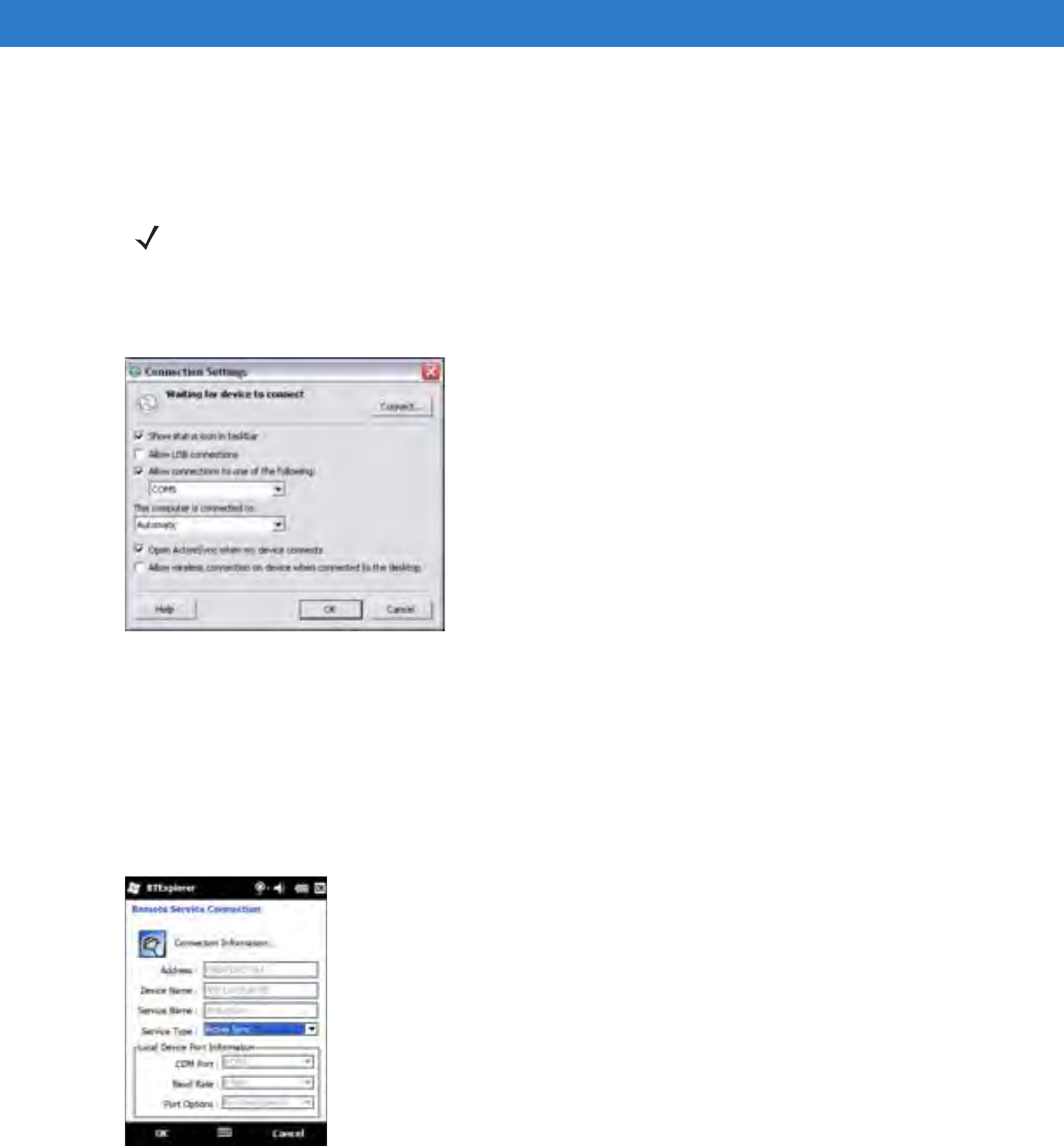
Using Bluetooth 6 - 29
3. In the Local COM Port: drop-down list select a COM port.
4. Tap Finish.
ActiveSync Using Serial Port Services
Use the wireless Bluetooth serial port connection for ActiveSync just as you would a physical serial cable
connection. You must configure the application that will use the connection to the correct serial port.
Figure 6-31
ActiveSync Connection Settings Window on PC
To establish an ActiveSync connection:
1. Ensure that the Sync profile is enabled on the MC75A. See Profiles Tab on page 6-45 for more information.
2. Use the Connection Wizard to search for a Bluetooth device, such as a PC. In the drop-down list select
ActiveSync via Bluetooth.
3. Select the device and tap Next. The Connection Favorite Options window appears.
4. Tap Connect. The Remote Service Connection window appears.
Figure 6-32
Remote Service Connection Window
5. In the Service Type drop-down list, select Active Sync.
NOTE By default, COM ports COM5, COM9, COM11, COM21, COM22 and COM23 are Bluetooth virtual ports. If an
application opens one of these ports, the Bluetooth driver activates and guides you through a Bluetooth
connection.
DRAFT

6 - 30 MC75A Enterprise Digital Assistant User Guide
6. Tap OK. The MC75A connects the PC and an ActiveSync session begins.
7. Tap Finish. The Connection Favorite Options window appears.
8. To end the session, tap the ActiveSync icon in the Favorite window and select Disconnect from the pop-up
window.
Personal Area Network Services
Connect two or more Bluetooth devices to share files, collaborate, or play multi-player games. To establish a
Personal Area Network connection:
1. Ensure that the Personal Area Networking profile is enabled on the MC75A. See Profiles Tab on page 6-45
for more information.
2. Use the Connection Wizard to search for a Bluetooth device.
3. Select the device and tap Next. The Connection Favorite Options window appears.
4. Tap Next. The Connection Summary window appears.
5. Tap Connect. The MC75A connects to the Bluetooth device.
IrMC Synchronization Services
IrMC Synchronization is used to synchronize PIM contacts between a remote device and the MC75A. To establish
an IrMC synchronization:
1. Ensure the MC75A is connectable (required when automatic re-connect is initiated). See Device Info Tab on
page 6-34.
2. Ensure that the Sync profile is enabled on the MC75A. See Profiles Tab on page 6-45 for more information.
3. Tap Menu > Settings > Services tab.
4. Tap Add button.
5. Select IrMC Synchronization.
6. Tap OK. The Edit Local Services window appears.
7. Tap OK twice.
8. Use the Connection Wizard to search for a Bluetooth device, such as a Car Kit.
9. Select the device and tap Next. The Connection Favorite Options window appears.
10. Tap and hold IrMA Synchronization and select Connect in the pop-up menu.
A2DP/AVRCP Services
A2DP/AVRCP is used to connect to a high-quality stereo headset:
NOTE This profile supports Ad-hoc and PAN User. Network Access Profile is not supported.
NOTE To automatically transfer contact with a Car Kit, ensure that the IrMC Synchronization service is enabled on
the MC75A.
DRAFT

Using Bluetooth 6 - 31
1. Ensure the MC75A is connectable (required when automatic re-connect is initiated). See Device Info Tab on
page 6-34.
2. Ensure that the remote Bluetooth device is in discoverable mode. See the devices user manual for
instructions.
3. Ensure that the A2DP/AVRCP profile is enabled on the MC75A. See Profiles Tab on page 6-45 for more
information.
4. Tap Menu > Settings > Services tab.
5. Tap Add button.
6. Select Advanced Audio Distribution Services.
7. Tap OK. The Edit Local Services window appears.
8. Tap OK twice.
9. Tap Menu > New Connection.
10. Select Connect to High-Quality Audio from the drop-down list.
11. Tap Next.
12. Select the device and tap Next.
13. Enter the PIN Code for the remote device and then tap OK. The Connection Favorite Options window
appears.
14. Ta p Next.
15. Ta p Connect. The MC75A connects to the high-quality audio headset.
For stereo headsets that can use hands-free services, connect to the hands-free service after connecting to the
A2DP service:
1. Tap Menu > New Connection.
2. Select Connect to Headset from the drop-down list.
3. Tap Next.
4. Select the stereo headset and tap Next.
5. Select the Hands-Free unit service and then tap Next.
6. Tap Next.
7. Tap Connect.
Connect to a HID Device
The MC75A can connect to an Human Interface Device (HID) device such as a Bluetooth keyboard:
1. Ensure the MC75A is connectable (required when automatic re-connect is initiated). See Device Info Tab on
page 6-34.
2. Ensure that the remote Bluetooth device is in discoverable mode. See the device user manual for instructions.
3. Ensure that the HID Client profile is enabled on the MC75A. See Profiles Tab on page 6-45 for more
information.
DRAFT
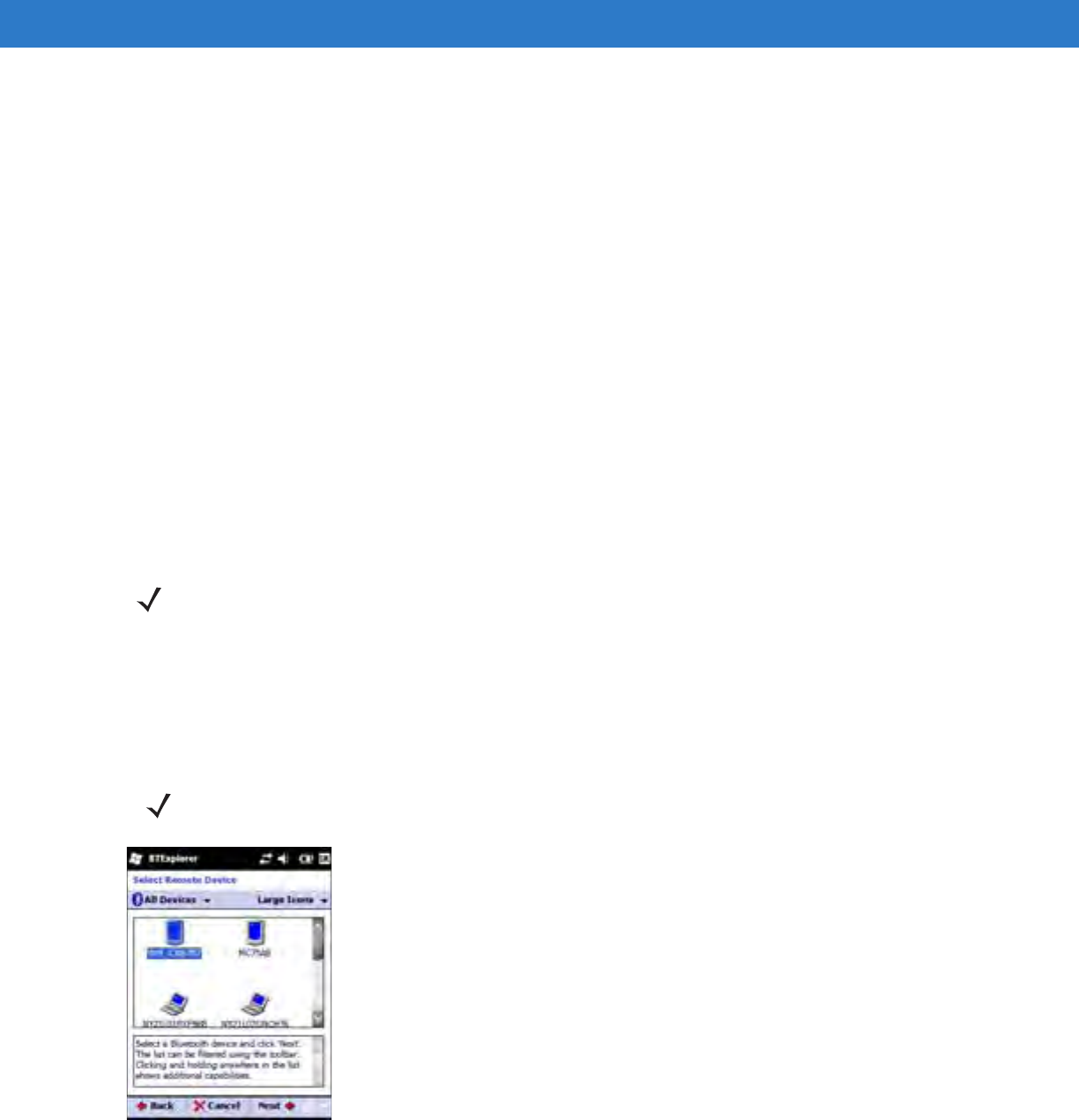
6 - 32 MC75A Enterprise Digital Assistant User Guide
4. Tap Menu > New Connection.
5. Select Explore Services on Remote Device from the drop-down list.
6. Tap Next.
7. Select the device and tap Next.
8. Select the service and tap Next.
9. The Connection Favorite Options window appears.
10. Ta p Next.
11. Tap Connect. The MC75A connects to the HID device.
Bonding with Discovered Device(s)
A bond is a relationship created between the MC75A and another Bluetooth device in order to exchange
information in a secure manner. Creating a bond involves entering the same PIN on the two devices. After creating
a bond and turning on the Bluetooth radios, the devices recognize the bond and can exchange information without
re-entering a PIN.
To bond with a discovered Bluetooth device:
1. Tap Start > BTExplorer. The BTExplorer window appears.
2. Tap Menu > New Connection. The New Connection Wizard window appears.
3. In the drop-down list, select Pair with Remote Device.
4. Tap Next. The Select Remote Device window appears.
Figure 6-33
Select Remote Device Window
5. Select a device from the list and tap Next. The PIN Code Request window appears.
NOTE If favorite connections have already been created, the Favorites screen displays. If no favorite connections
have been created, the New Connection Wizard screen displays.
NOTE Devices discovered previously are listed to save time. To start a new device discovery, tap and hold on the list
area and select Discover Devices from the pop-up menu.
DRAFT
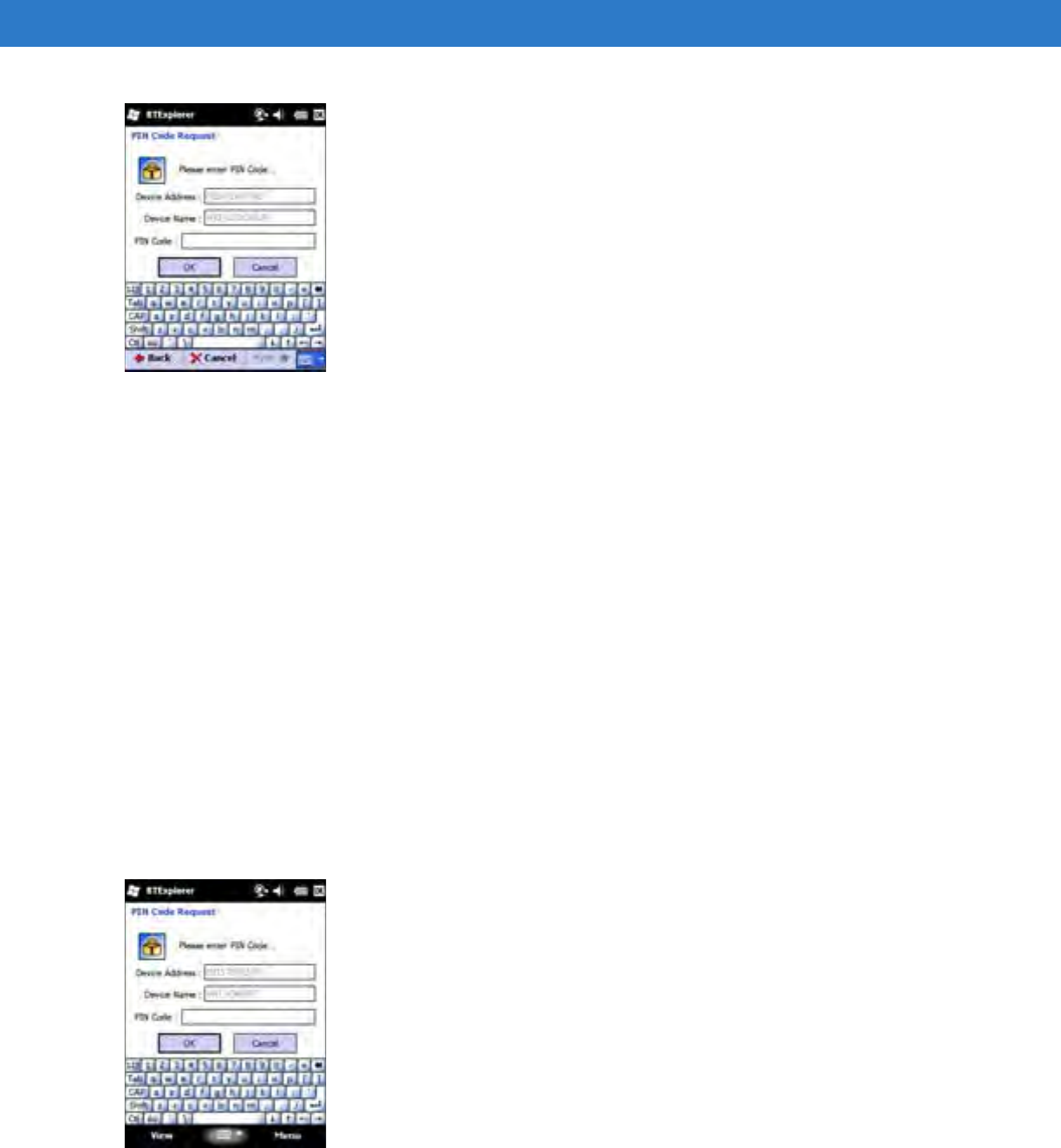
Using Bluetooth 6 - 33
Figure 6-34
Connection Favorite Options Window
6. In the PIN Code field, enter the PIN code.
7. Tap OK. The Pairing Status window displays.
8. Tap Finish. The devices are successfully paired. The device name moves to the Trusted Devices window.
Deleting a Bonded Device
To delete a device no longer needed:
1. Tap Start > BTExplorer. The BTExplorer window appears.
2. Tap Menu > Trusted Devices. The Trusted Devices window appears.
3. Tap and hold on the device select Delete Link Key in the pop-up menu.
4. A confirmation dialog appears. Tap Yes.
Accepting a Bond
When a remote device wants to bond with the MC75A, enter a PIN when requested to grant permission.
1. Ensure that the MC75A is set to discoverable and connectable. See Bluetooth Settings on page 6-34. When
prompted to bond with the remote device the PIN Code Request window appears.
Figure 6-35
PIN Code Request Window
DRAFT
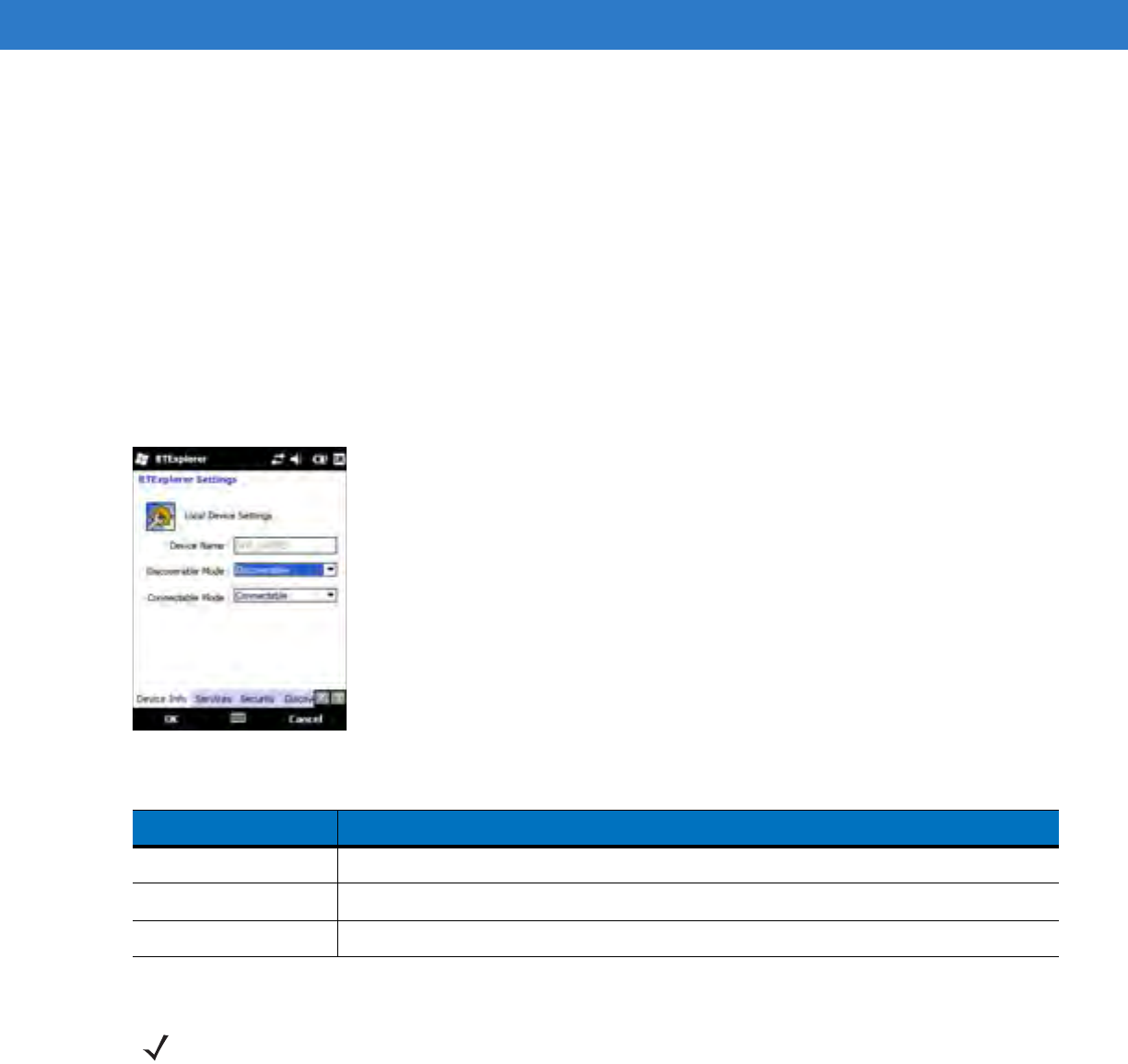
6 - 34 MC75A Enterprise Digital Assistant User Guide
2. In the PIN Code: text box, enter the same PIN entered on the device requesting the bond. The PIN must be
between 1 and 16 characters.
3. In the Device Name: text box, edit the name of the device requesting the bond, if desired.
4. Tap OK to create the bond. The MC75A can now exchange information with the other device.
Bluetooth Settings
Use the BTExplorer Settings window to configure the operation of the BTExplorer application. Tap Menu >
Settings. The BTExplorer Settings window appears.
Device Info Tab
Use the Device Info tab to configure the MC75A’s Bluetooth connection modes.
Figure 6-36
BTExplorer Settings - Device Info Tab
Services Tab
Use the Services tab to add or delete Bluetooth services.
Table 6-3
Device Info Tab Data
Item Description
Device Name Displays the name of the MC75A.
Discoverable Mode Select whether or not the MC75A is discoverable by other Bluetooth devices.
Connectable Mode Select whether or not the MC75A is connectable by other Bluetooth devices.
NOTE Ensure that the MC75A is discoverable and connectable when remote devices use MC75A services.
DRAFT

Using Bluetooth 6 - 35
Figure 6-37
BTExplorer Settings - Services Tab
To add a service:
1. Tap Add. The Add Local Service window displays.
Figure 6-38
Add Local Service Window
2. In the list, select a service to add.
3. Tap OK. The Edit Local Service window displays for the selected service.
4. Select the appropriate information and then tap OK. See the following sections for information on the available
services.
Dial-Up Networking Service
Dial-up Networking allows other Bluetooth devices to access a dial-up modem.
DRAFT

6 - 36 MC75A Enterprise Digital Assistant User Guide
Figure 6-39
BTExplorer Settings - Dial-up Networking Information
File Transfer Service
File transfer allows other Bluetooth devices to browse files.
Table 6-4
Dial-up Networking Information Data
Item Description
Service Name Displays the name of the service.
Service Security Select the type of security from the drop-down list. Options are None, Authenticate, or
Authenticate/Encrypt.
Local COM Port Select the COM port.
Local Baud Rate Select the communication baud rate.
Local Port Options Select the port option.
DRAFT
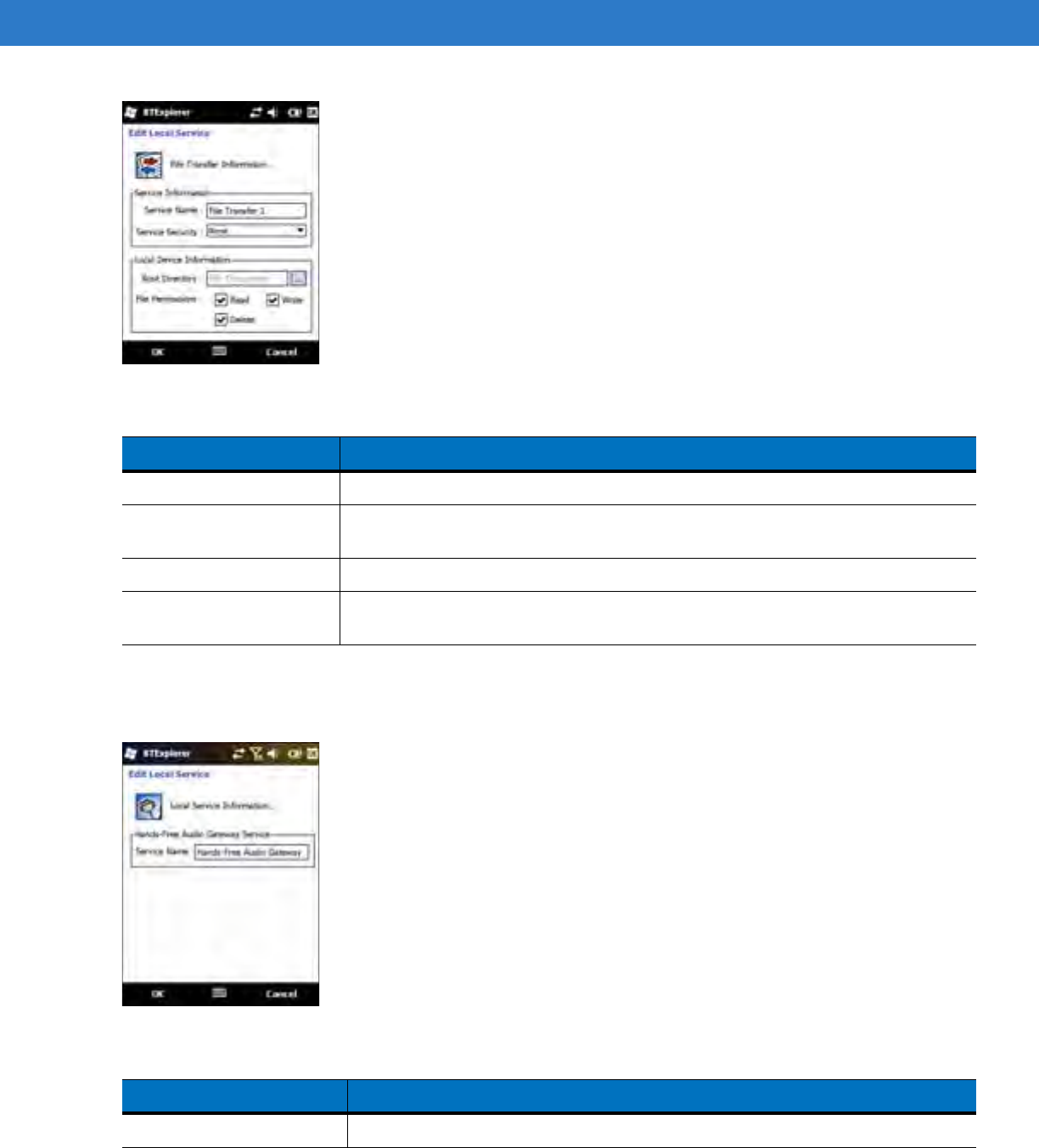
Using Bluetooth 6 - 37
Figure 6-40
BTExplorer Settings - File Transfer Information
Hands-Free Audio Gateway Service
Hands-Free Service Audio Gateway allows connection to hands-free devices.
Figure 6-41
BTExplorer Settings - Hands-Free Audio Gateway
Table 6-5
File Transfer Information Data
Item Description
Service Name Displays the name of the service.
Service Security Select the type of security from the drop-down list. Options are None, Authenticate,
or Authenticate/Encrypt.
Root Directory Select the directory that other Bluetooth devices can access.
File Permissions Select the file permissions for the selected directory. Check the appropriate box to
grant read access, write access, and delete access.
Table 6-6
Hands-Free Audio Gateway Data
item Description
Service Name Lists the name of the audio service.
DRAFT
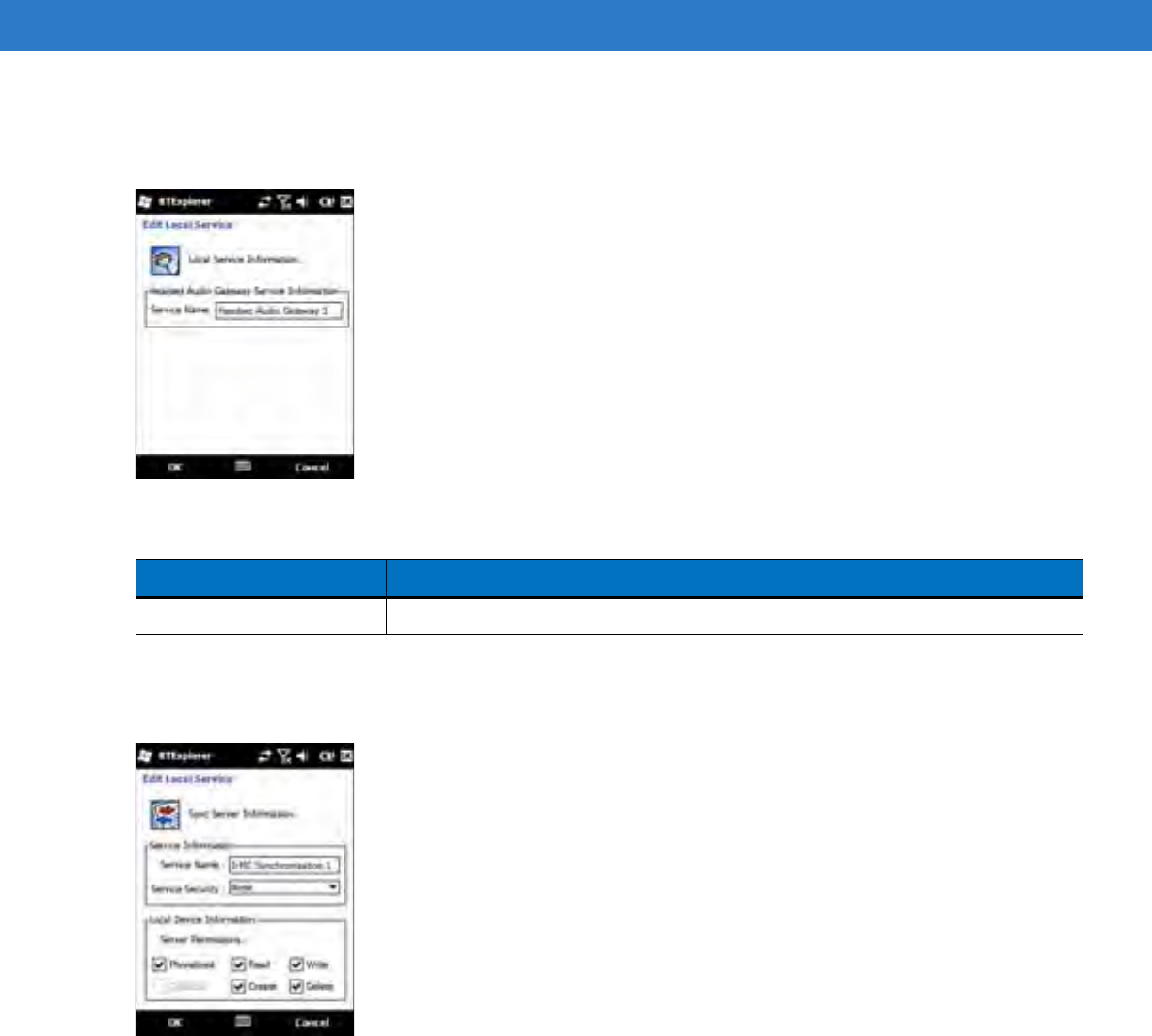
6 - 38 MC75A Enterprise Digital Assistant User Guide
Headset Audio Gateway Service
Headset Service Audio Gateway allows connection to headset devices.
Figure 6-42
BTExplorer Settings - Headset Audio Gateway
IrMC Synchronization Service
The IrMC Synchronization service used to synchronize PIM contacts between a remote device and the MC75A.
Figure 6-43
BTExplorer Settings - IrMC Synchronization
Table 6-7
Headset Audio Gateway Data
Item Description
Service Name Lists the name of the audio service.
DRAFT
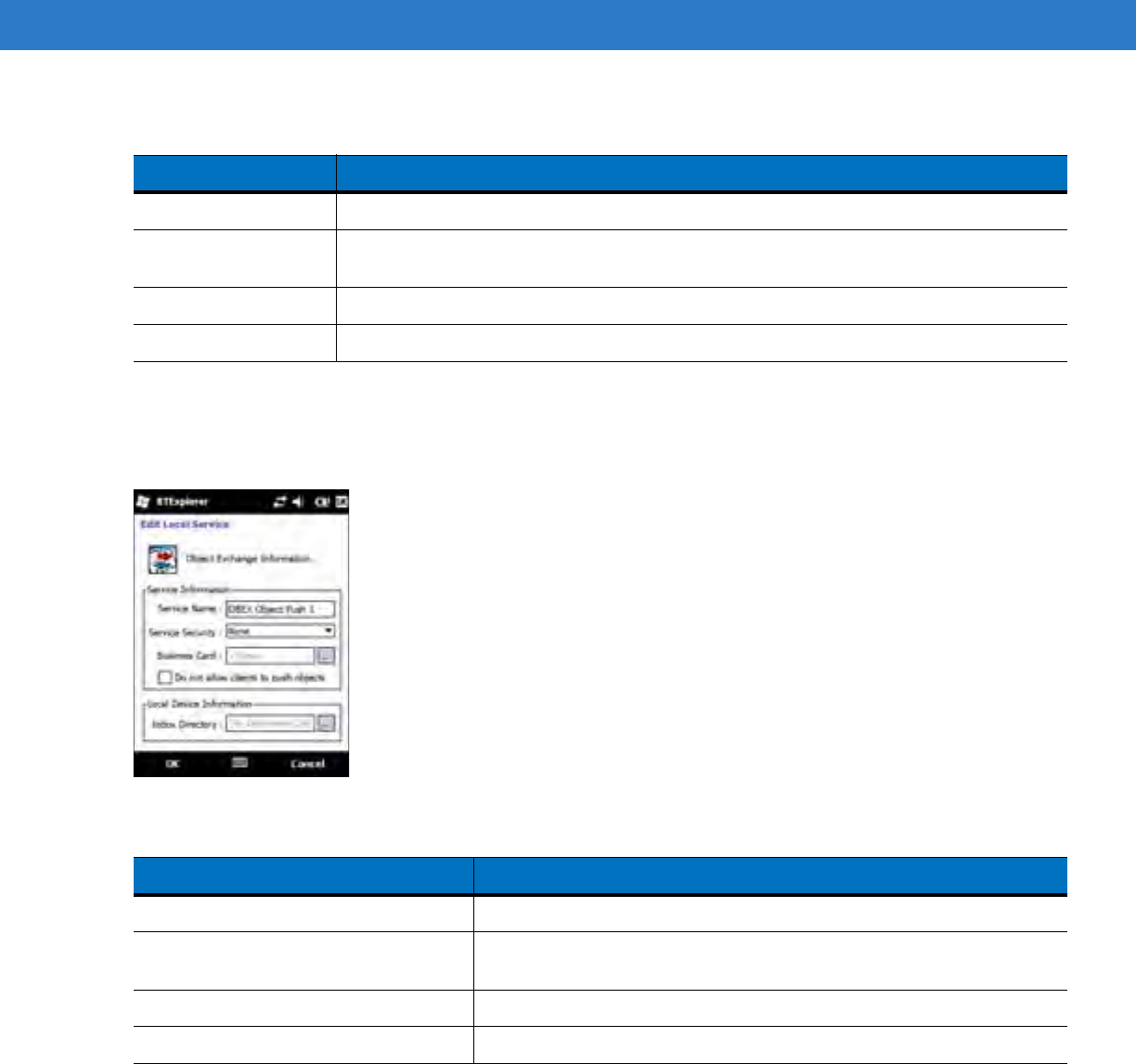
Using Bluetooth 6 - 39
OBEX Object Push Service
OBEX Object Push allows other Bluetooth devices to push contacts, business cards, pictures, appointments, and
tasks to the MC75A.
Figure 6-44
BTExplorer Settings - OBEX Exchange Information
Personal Area Networking Service
Personal Area Networking hosts a Personal Area Network which allows communication with other Bluetooth
devices.
Table 6-8
IrMC Synchronization Data
Item Description
Service Name Displays the name of the service.
Service Security Select the type of security from the drop-down list. Options are None, Authenticate, or
Authenticate/Encrypt.
Phonebook Select the Phonebook checkbox to allow synchronization with the MC75A’s contacts.
Select Read, Write, Create and/or Delete to allow phonebook permissions.
Table 6-9
OBEX Exchange Information Data
Item Description
Service Name Displays the name of the service.
Service Security Select the type of security from the drop-down list. Options are None,
Authenticate, or Authenticate/Encrypt.
Do not allow clients to push objects Disables clients from pushing objects to the MC75A.
Inbox Directory Select a directory where another Bluetooth device can store files.
DRAFT
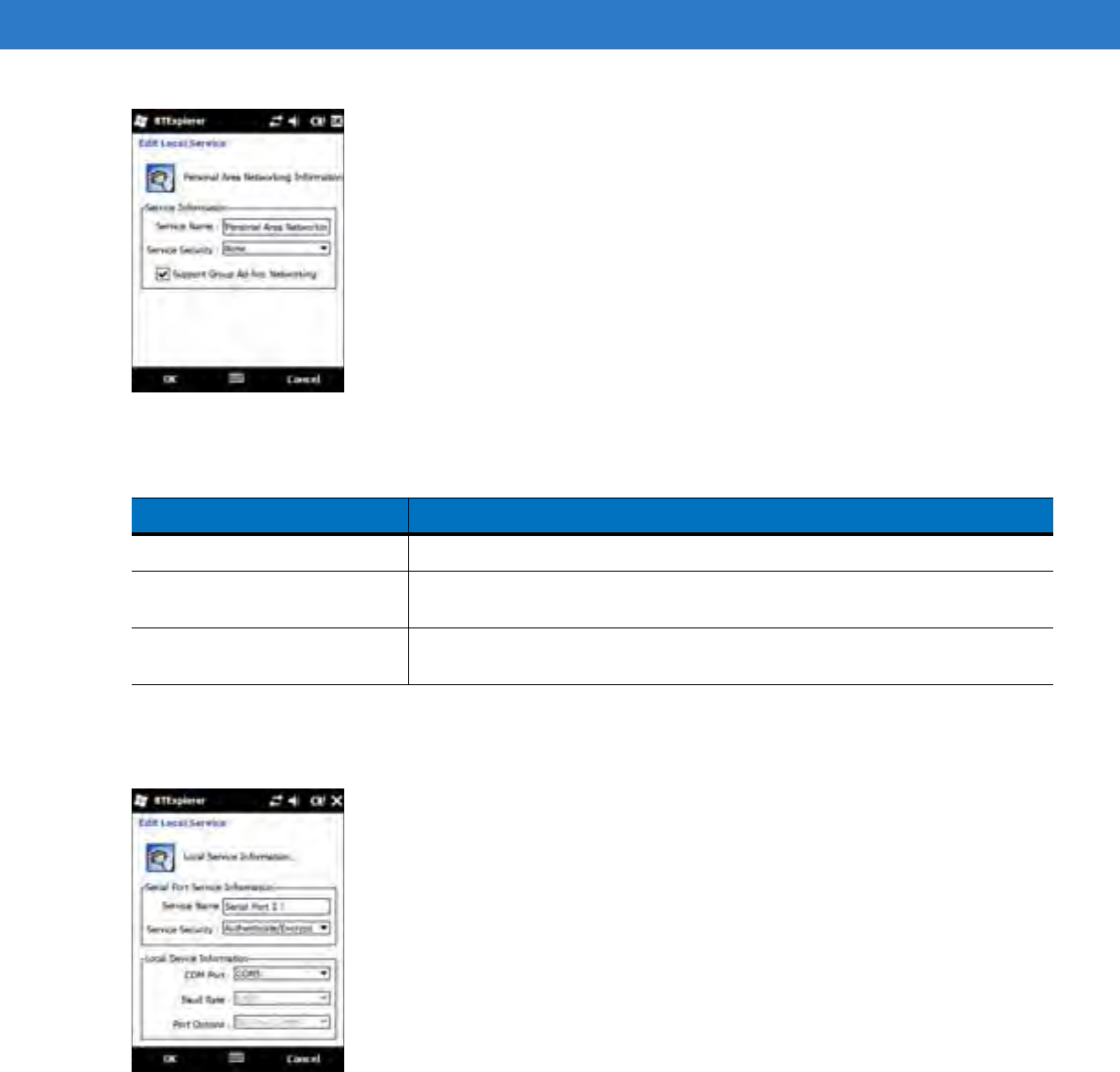
6 - 40 MC75A Enterprise Digital Assistant User Guide
Figure 6-45
BTExplorer Settings - Personal Area Networking
Serial Port Service
Serial port allows other Bluetooth devices to access COM ports.
Figure 6-46
BTExplorer Settings - Serial Port Services
Table 6-10
Personal Area Networking Data
Item Description
Service Name Displays the name of the service.
Service Security Select the type of security from the drop-down list. Options are None,
Authenticate, or Authenticate/Encrypt.
Support Group Ad-Hoc
Networking Select to enable Ad-Hoc networking.
DRAFT
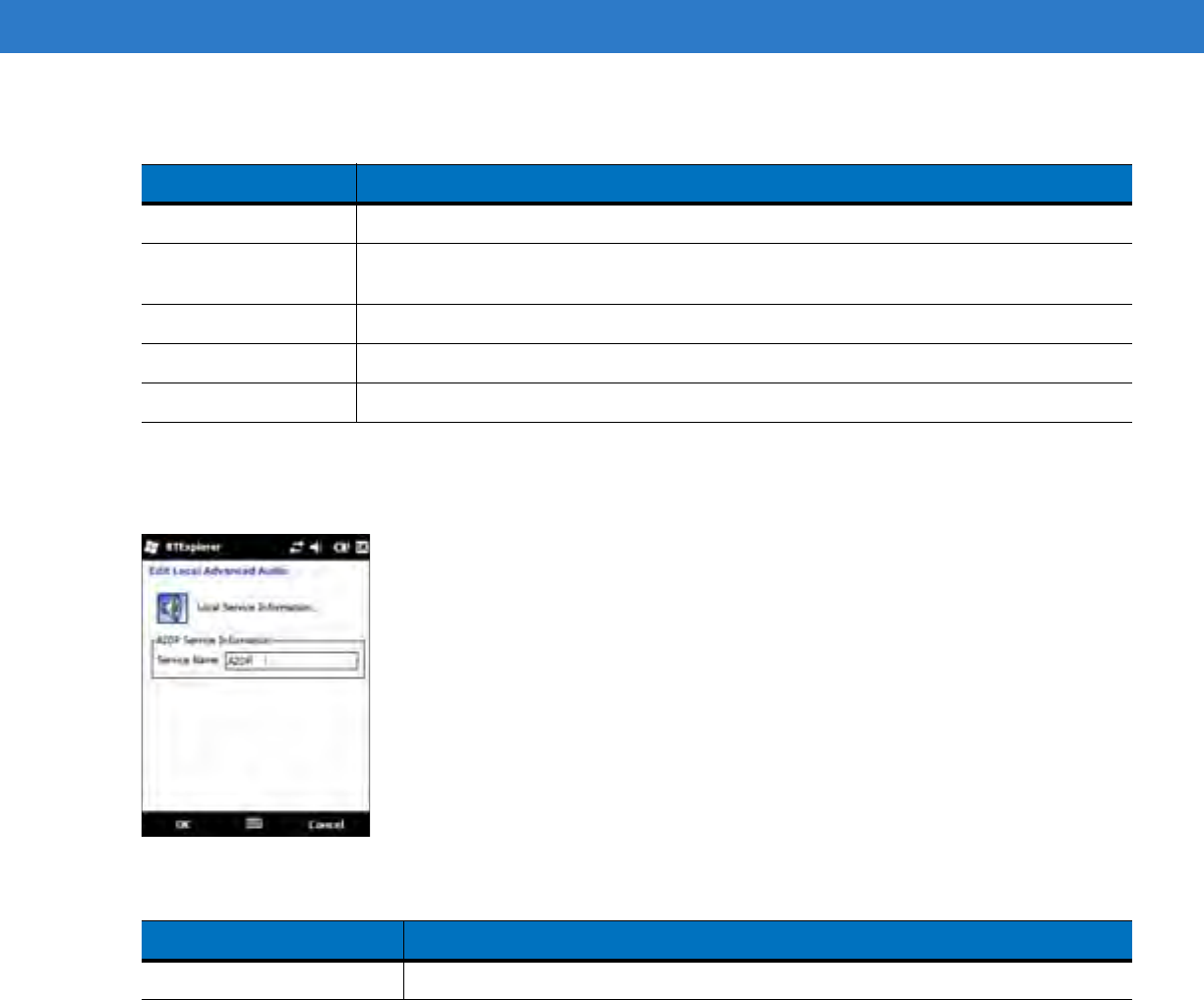
Using Bluetooth 6 - 41
Advanced Audio Distribution Service
Advanced Audio Distribution hosts connects from Bluetooth devices supporting high-quality stereo audio.
Figure 6-47
BTExplorer Settings - Advanced Audio Distribution
Table 6-11
Serial Port Services Data
Item Description
Service Name Displays the name of the service.
Service Security Select the type of security from the drop-down list. Options are None, Authenticate, or
Authenticate/Encrypt.
Local COM Port Select the COM port.
Local Baud Rate Select the communication baud rate.
Local Port Options Select the port option.
Table 6-12
Advanced Audio Distribution Data
Item Description
Service Name Lists the name of the audio service.
DRAFT
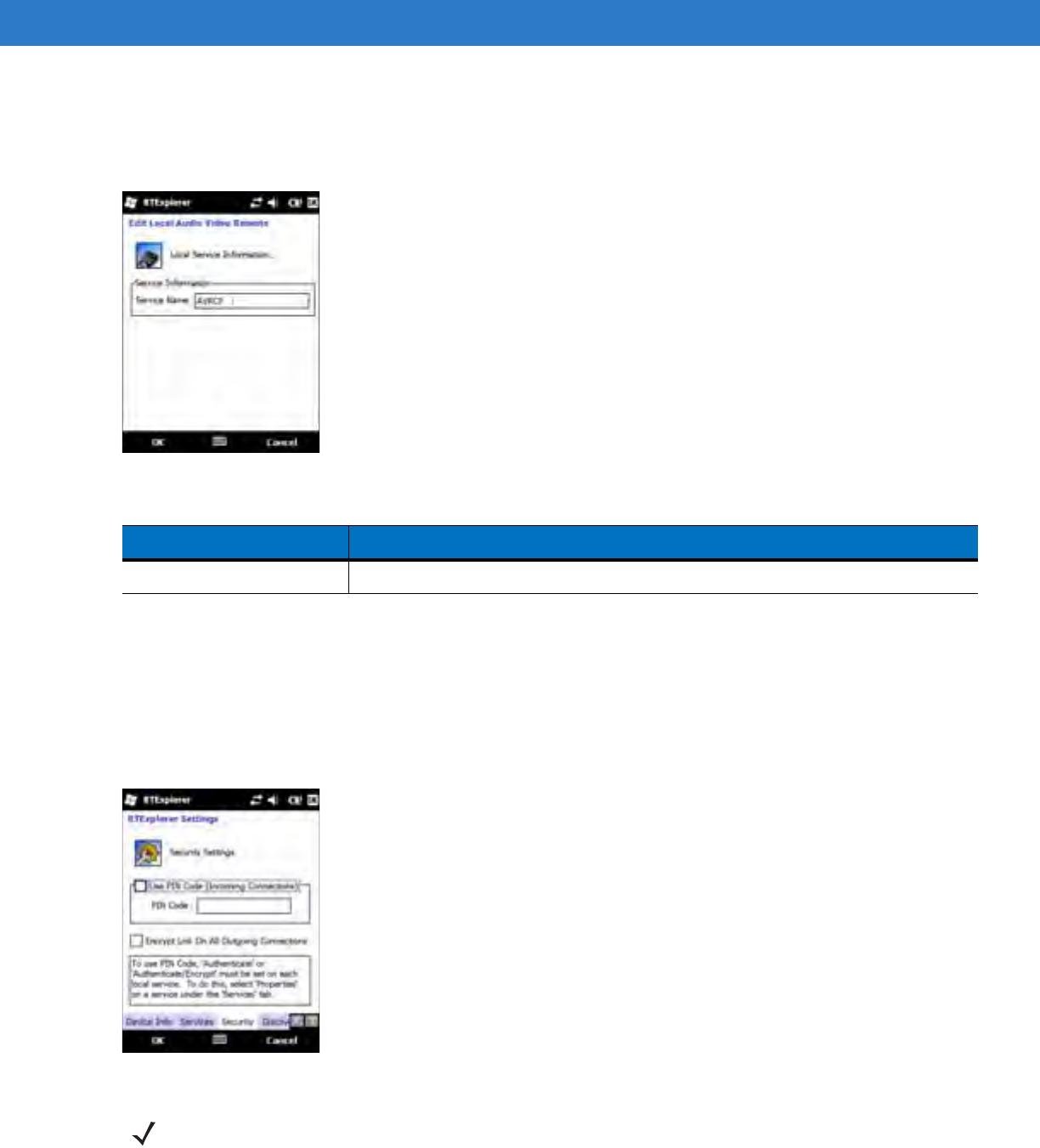
6 - 42 MC75A Enterprise Digital Assistant User Guide
Audio Video Remote Control Service
Audio Video Remote Control hosts connections from Bluetooth devices supporting audio remote-control
functionality.
Figure 6-48
BTExplorer Settings - Audio Video Remote Control
Security Tab
Security settings allows you to set global security policies for Bluetooth. Note that these settings are only active on
local Services that are set to Authenticate or Authenticate/Encryption. You can set authentication on local Services
under the Services tab.
To adjust the security settings for an individual service, select the Services tab first, then select the individual
service, then Properties.
Figure 6-49
BTExplorer Settings - Security Tab
Table 6-13
Audio Video Remote Control Data
Item Description
Service Name Lists the name of the audio service.
NOTE To use PIN Code, select Authenticate or Authenticate/Encrypt from the Service Security drop-down
list on each local service.
DRAFT

Using Bluetooth 6 - 43
Discovery Tab
Use the Discovery tab to set and modify discovered devices.
Figure 6-50
BTExplorer Settings - Discovery Tab
Virtual COM Port Tab
Virtual COM Port defines which COM ports BTExplorer attempts to use for virtual COM ports. Check the
appropriate checkbox to use the port as a virtual COM port. When finished, choose Apply to enforce changes, or
Revert to restore the original settings.
Table 6-14
Security Tab Data
Item Description
Use PIN Code (Incoming
Connection) Select for automatic use of the PIN code entered in the PIN Code text box.
It is recommended not to use this automatic PIN code feature. See Security
on page 6-2 for more information.
PIN Code Enter the PIN code.
Encrypt Link On All Outgoing
Connections Select to enable or disable encryption on all outgoing connections to other
Bluetooth devices.
Table 6-15
Discovery Tab Data
Item Description
Inquiry Length Sets the amount of time the MC75A takes to discover Bluetooth devices in
the area.
Name Discovery Mode Select either Automatic or Manual to automatically attempt to discover a
Bluetooth device's name after finding the device.
Discovered Devices - Delete
Devices Deletes all discovered devices and link keys from memory.
Discovered Devices - Delete
Linked Keys Removes all pairing from remote Bluetooth devices, and makes them all
un-trusted.
DRAFT
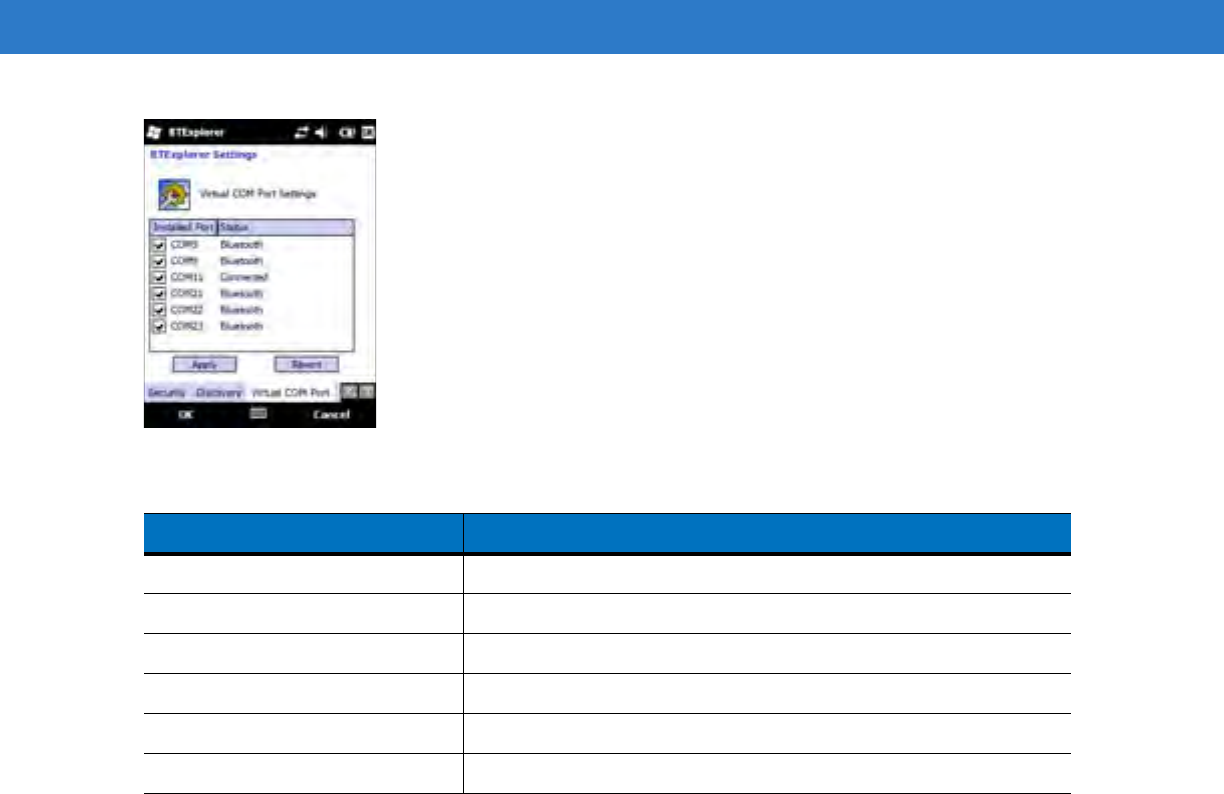
6 - 44 MC75A Enterprise Digital Assistant User Guide
Figure 6-51
BTExplorer Settings - Virtual COM Port Tab
HID Tab
Use the HID tab to select The Human Interface Device Profile programming interface defines the protocols and
procedures to be used to implement HID capabilities.
Provides support for devices such as mice, joysticks, keyboards.
Table 6-16
Virtual COM Port Tab Data
Item Description
COM5:Bluetooth Enable or disable COM Port 5.
COM9:Bluetooth Enable or disable COM Port 9.
COM11:Bluetooth Enable or disable COM Port 11.
COM21:Bluetooth Enable or disable COM Port 21.
COM22:Bluetooth Enable or disable COM Port 22.
COM23:Bluetooth Enable or disable COM Port 23.
DRAFT

Using Bluetooth 6 - 45
Figure 6-52
BTExplorer Settings - HID Tab
Profiles Tab
Use the Profile tab to load or remove Bluetooth services profiles. If a profile is not used, it can be removed to save
memory.
Figure 6-53
BTExplorer Settings - Profile Tab
1. Tap a check box next to the profile to load (activate).
The Serial Port profile is always active and cannot be removed.
2. Tap Select All to select all profiles or tap Deselect All to deselect all profiles.
3. Tap Apply to activate the profiles and then Close to exit the application.
Table 6-17
HID Tab Data
Item Description
Enable Key Repeat Enables key repeat functionality.
Delay To increase key repeat delay, drag the Delay slider to the right. To decrease
key repeat delay, drag the Delay slider to the left.
Rate To increase key repeat speed, drag the Rate slider to the left. To decrease
key repeat speed, drag the Rate slider to the right.
DRAFT

6 - 46 MC75A Enterprise Digital Assistant User Guide
System Parameters Tab
Figure 6-54
BTExplorer Settings - System Parameters Tab
Miscellaneous Tab
Figure 6-55
BTExplorer Settings - Miscellaneous Tab
Table 6-18
System Parameters Tab Data
item Description
Page Timeout Sets the amount of time the MC75A searches for a device before moving on
the next device.
Link Supervision Timeout Sets the amount of time that the MC75A will wait for a device to come back
into range after it has gone out of range. If the device does not come back
into range by the set time, the MC75A drops the connection.
DRAFT

Using Bluetooth 6 - 47
Table 6-19
Miscellaneous tab Data
Item Description
Highlight Connections Select the connection type to highlight when connected. In the Wizard Mode,
the only options are Favorites or None. In the Explorer Mode the options are
None, Tree View Only, List View Only, or Tree and List View.
Apply Text Style Select the text style to apply to the connection text.
Apply Text Color Select the text color to apply to the connection text.
DRAFT

6 - 48 MC75A Enterprise Digital Assistant User Guide
DRAFT

Chapter 7 Accessories
Introduction
MC75A accessories, listed below, provide a variety of product support capabilities.
Table 7-1
MC75A Accessories
Accessory Part Number Description
Cradles
Single Slot USB/Serial
Cradle CRD7X00-1000RR Charges the MC75A main battery and a spare battery.
Synchronizes the MC75A with a host computer through a
USB connection.
Four Slot Ethernet Cradle CRD7000-4000ER Charges the MC75A main battery and connects the
MC75A with an Ethernet network.
Four Slot Charge Only
Cradle CRD7X00-4000CR Charges up to four MC75A devices.
VCD7000 Vehicle Cradle VCD7X00-P000R Installs in a vehicle and charges the MC75A main battery
and a spare battery. Provides serial data communication
between an MC75A and an external device.
Chargers
Four Slot Battery Charger SAC7X00-4000CR Charges up to four MC75A spare batteries. Includes an
MC75A shim.
Serial Charging Cable 25-102776-01R Provides power to the MC75A and serial communication
with a host computer.
USB Charging Cable 25-102775-01R Provides power to the MC75A and USB communication
with a host computer.
Charge Only Cable 25-95214-02R Provides power to the MC75A.
Auto Charge Cable 25-70979-01R Charges the MC75A using a vehicle’s cigarette lighter.
Cables
DRAFT

7 - 2 MC75A Enterprise Digital Assistant User Guide
Single Slot USB/Serial Cradle
This section describes how to use a Single Slot USB/Serial cradle with the MC75A. For USB communication setup
procedures refer to the MC75A Integrator Guide.
DEX Cable 25-76793-01R Connects the MC75A to a vending machine.
Modem Inverter Cables 25-70924-03R Modem inverter cable.
O’Neil Printer Cable 25-91519-01R Printer cable for O’Neil printers.
Zebra Printer Cable 25-91518-01R Printer cable Zebra Road Warrior printers.
Zebra Printer Cable 25-91515-01R Printer cable for Zebra QL printers.
Miscellaneous
Magnetic Stripe Reader
(MSR) MSR7000-100R Snaps on to the MC75A and adds magstripe read
capabilities.
Debit Card Reader DCR7X00-100R
Allows easy data capture with the swipe of a magnetic
stripe card and personal identification number (PIN)
entry using a numeric keypad.
Snap-on Mobile Payment
Module with Chip and PIN DCR7X00-200R Allows easy data capture with magnetic stripe cards, EMV
compliant Chip and PIN cards and personal identification
number (PIN) entry using a numeric keypad.
Modem Dongle MDM9000-100R
Provides modem connectivity.
Spare 3600 mAh
lithium-ion battery BTRY-MC7XEAB00 Replacement 3600 mAh battery.
Spare 4800 mAh
lithium-ion battery BTRY-MC7XEAB0H Optional 4800 mAh battery.
Battery Kit for 3600 mAh
battery BTRY-KT-1R5X-MC7XR Replacement 3600 mAh battery and battery door.
Battery Kit for 4800 mAh
battery BTRY-KT-2R5X-MC7XR Replacement 4800 mAh battery and battery door.
Headset 50-11300-050R Use in noisy environments.
Belt Mounted Rigid Holster SG-MC70011110-01R Clips onto belt to hold the MC75A when not in use.
Fabric Holster SG-MC7521215-01R Soft holder for added protection.
Stylus Stylus-00002-03R Replacement stylus (3-pack).
Wall Mounting Kit 8710-050006-01R Use for wall mounting the four slot cradles.
Screen Protector KT-67525-01R Package of 3 screen protectors.
Software - Enterprise Mobility Developer Kits (EMDKs), available at:
http://support.symbol.com.
Table 7-1
MC75A Accessories (Continued)
Accessory Part Number Description
DRAFT

Accessories 7 - 3
The Single Slot USB/Serial Cradle:
•
Provides 5.4 VDC power for operating the MC75A.
•
Synchronizes information between the MC75A and a host computer. Refer to the MC75A Integrator Guide for
information on setting up a partnership between the MC75A and a host computer.
•
Charges the MC75A’s battery.
•
Charges a spare battery.
Charging the MC75A Battery
Connect the cradle to power. Insert the MC75A into the slot to begin charging.
Figure 7-1
MC75A Battery Charging
Charging the Spare Battery
Figure 7-2
Spare Battery Charging
Charging/Battery Status
LED
Spare Battery Spare Battery
Charging LED
DRAFT
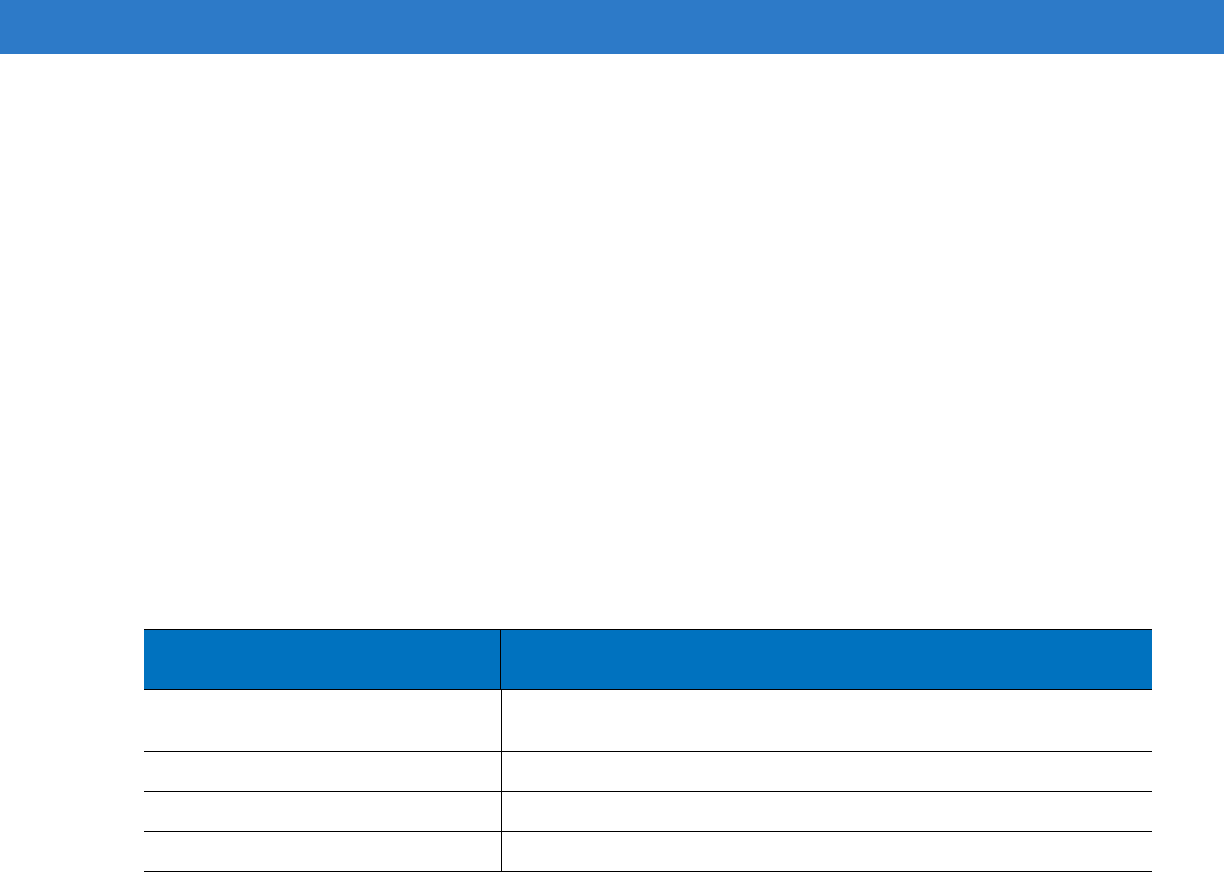
7 - 4 MC75A Enterprise Digital Assistant User Guide
Battery Charging Indicators
The Single Slot USB/Serial Cradle charges the MC75A’s main battery and a spare battery simultaneously.
The MC75A’s charge LED indicates the status of the battery charging in the MC75A. See Table 1-2 on page 1-7 for
charging status indications.
The spare battery charging LED on the cradle indicates the status of the spare battery charging in the cradle. See
Table 7-2 for charging status indications.
The 3600 mAh battery fully charges in less than five hours and the 4800 mAh battery fully charges in less than
seven hours.
Charging Temperature
Charge batteries in temperatures from 0°C to 40°C (32°F to 104°F). Charging is intelligently controlled by the
MC75A.
To accomplish this, for small periods of time, the MC75A or accessory alternately enables and disables battery
charging to keep the battery at acceptable temperatures. The MC75A or accessory indicates when charging is
disabled due to abnormal temperatures via its LED. See Table 1-2 on page 1-7 and Table 7-2.
Table 7-2
Spare Battery LED Charging Indicators
Spare Battery LED
(on cradle) Indication
Off Battery is not charging; battery is not inserted correctly in the cradle;
cradle is not powered
Slow Blinking Amber Spare battery is charging.
Solid Amber Charging complete.
Fast Blinking Amber Charging error.
DRAFT